 28/06/2009 13:19 28/06/2009 13:19 |
|
| | | OFFLINE | | Post: 17.806
Post: 476 | Registrato il: 28/08/2005
Registrato il: 20/01/2009 | Administratore | Utente Senior | |
|


 POPE RECEIVES ECUMENICAL
POPE RECEIVES ECUMENICAL
DELEGATION TO PAULINE YEAR CLOSING
AND FEAST OF SAINTS PETER & PAUL

At 12:30 yesterday afternoon, the Holy Father Benedict XVI received a delegation from the Ecumenical Patriarchate of Constantinople who came to Rome for the Feast of Saints Peter and Paul and for the conclusion of the Pauline Year, which was also observed by the Orthodox Churches.

The delegation sent by His Holiness Bartholomew I, Patriarch of Constantinople, was led by His Eminence Emmanuel, Metropolitan of France and director of the Orthodox Church representation at the European Union.
It includes His Eminence Athenagoras, Bishop of Synope and Assistant to the Metropolitan of Belgium; and the Rev. Deacon Ioakim Billis, from the Patriarchal See of Constantinople.
The delegation will take part Sunday afternoon in the celebration of Vespers to be presided by Benedict XVI at the Basilica of St. Paul outside the Walls, to conclude the Pauline Year, as well as in the Mass to be presided by the Holy Father in St. Peter's Basilica on Monday, Feast of Saints Peter and Paul.
For decades since the reconciliation meeting between Paul VI and Patriarch Athenagoras in 1964, the Rome and Constantinople have sent official delegations to each other's major patronal feast - June 29 for the Catholic church, and November 30, feast of St. Andrew, for the Orthodox Church.
Here is a translation of the Pope's address, delivered in French, to the delegation:
"Peace to you and peace from God our Father and the Lord Jesus Christ" (Eph 1,2).
Venerable Brothers,
With these words, St. Paul, "apostle of Christ Jesus by the will of God" addressed 'the holy ones' who lived in Ephesus and to "those who are faithful in Christ Jesus" (Eph 1,1).
Today, through this greeting of peace, I welcome you to the patronal feast of Saints Peter and Paul with which we are concluding the Pauline Year.
last year, the Ecumenical Patriarch, His Holiness Bartholomew I, honored us with his presence to celebrate together the inauguration of a year of prayer, of reflection and of an exchange of gestures of communion between Rome and Constantinople.
For our part, we had the joy of sending a delegation to the analogous celebrations organized by the Ecumenical Patriarchate [on the Feast of Saint Andrew].
It could not have been otherwise in the year dedicated to St. Paul who exhorted vigorously "to preserve the unity of the spirit through the bond of peace", teaching us that there is only "one body and one Spirit" (Eph 4,3-4).
Welcome then, dear brothers who have been sent by His Holiness, the Ecumenical Patriarch, to whom in turn, please convey my warm and fraternal greetings in the Lord.
Together, let us give thanks to the Lord for all the fruits and benefits brought to us during the bimillenary celebration of the birth of St. Paul.
We will be celebrating together the feast of Saints Peter and Paul, the 'protothoni' of the apostles, as traditional Orthodox liturgy calls them, which means, they who occupy first place among the apostles and are also called 'masters of the ecumen'.
By your presence which is a sign of ecclesial fraternity, you remind us of our common involvement in the quest towards full communion.
You already know this, but it is my pleasure nonetheless to confirm that the Catholic Church intends to contribute in every way possible to the re-establishment of full unity, in response to Christ's wish for his disciples, and remembering the teaching of Paul who reminds us that we have all been called 'to a single hope'.
In this perspective, we can thus look forward confidently to a positive follow-through of the work done by the mixed international commission for theological dialog between the Orthodox and the Catholics.
This commission will meet again in October to consider a topic that is crucial for the relations between the East and the West, namely, "the role of the Bishop of Rome in the communion of the Church during the first millennium" [before the Great Schism of 1054 which split the Church into the Western Church (Catholic) and the Eastern (Orthodox-Byzantine)].
Study of this aspect is indispensable to be able to examine this issue in depth in the present framework of our quest for full communion.
This commission, which has already accomplished important work, will be generously hosted by the Orthodox Church of Cyprus to whom we now express our gratitude, because their fraternal welcome and the atmosphere of prayer which will surround the discussions can only facilitate our task of reciprocal understanding.
I wish that the participants of the Catholic-Orthodox dialog may know that my prayers go with them and that the dialog has the full support of the Catholic Church.
With all my heart, I hope that the misunderstandings and tensions among the Orthodox delegates during the last plenary sessions of the commission [at which the Russian Orthodox delegation walked out before it started, to protest Constantinople's involvement with the Orthodox Church of Estonia, which Moscow considers to be under its jurisdiction] may be overcome in fraternal love, so that this dialog may be more amply representative of the Orthodox world.
Dear brothers, I thank you once more for being with us today and I ask you to convey my fraternal greeting to the Ecumenical Patriarch, His Holiness Bartholomew I, to the Holy Synod, and to all the clergy, as well as the Orthodox faithful.
May the joy of the feast of Saints Peter and Paul which we traditionally celebrate on the same day fill your hearts with trust and hope.
[Modificato da TERESA BENEDETTA 15/07/2009 22:21] |
| |
|
| |
 28/06/2009 13:33 28/06/2009 13:33 |
|
| | | OFFLINE | | Post: 17.807
Post: 477 | Registrato il: 28/08/2005
Registrato il: 20/01/2009 | Administratore | Utente Senior | |
|

June 28
 St. Irenaeus of Lyons
St. Irenaeus of Lyons
(Greek, b. Smyrna ca 130-d. Lyons 230)
Bishop, Theologian, Martyr
OR today.

Benedict XVI tells Vietnamese bishops that the Church can work with the political community:
'Religions do not threaten the unity of a nation'
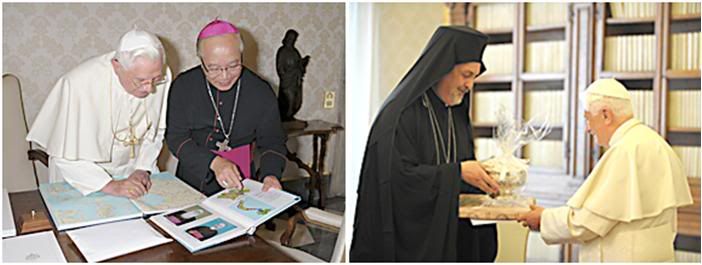
Other Page 1 stories: the Pope expresses the hope that the Orthodox Churches will soon resolve major intramural differences
in a meeting with the ecumenical delegation from Constantinople to the closing of the Pauline Year and the annual Feast
of Saints Peter and Paul; the exciting discovery June 19 of the oldest known image* of the Apostle Paul in a Roman
catacomb (middle photo, top row); an essay on how the Byzantine tradition considers the Apostles Peter and Paul as
'the two wings of knowing God'. The only international news is about the formation of a new government in Lebanon based
on the recent parliamentary elections in which center-right candidates beat out Hezbollah.
* Note the striking resemblance of the just-discovered image to the image of Paul represented in the icon of Peter and Paul (right photo, top row).
THE POPE'S DAY
Angelus today.
Vespers and closing of the Pauline Year at the Basilica of St. Paul outside the Walls.
[Modificato da TERESA BENEDETTA 15/07/2009 22:23] |
| |
 28/06/2009 14:11 28/06/2009 14:11 |
|
| | | OFFLINE | | Post: 17.808
Post: 478 | Registrato il: 28/08/2005
Registrato il: 20/01/2009 | Administratore | Utente Senior | |
|
 ANGELUS TODAY
ANGELUS TODAY
The Holy Father spoke today about the closing of the Pauline Year and the graces born from it as well as the start of the Year for Priests.
In English, he referred to today's Gospel:
I am happy to greet all the English-speaking pilgrims and visitors present for this Angelus Prayer.
Today’s Liturgy proclaims Jesus Christ, the Saviour who has done away with death and brought us life through his Gospel. May our thoughts and actions always be inspired by the words and deeds of Jesus whom we venerate as the Way, the Truth and the Life.
I wish you all a pleasant stay in Rome and a blessed Sunday!

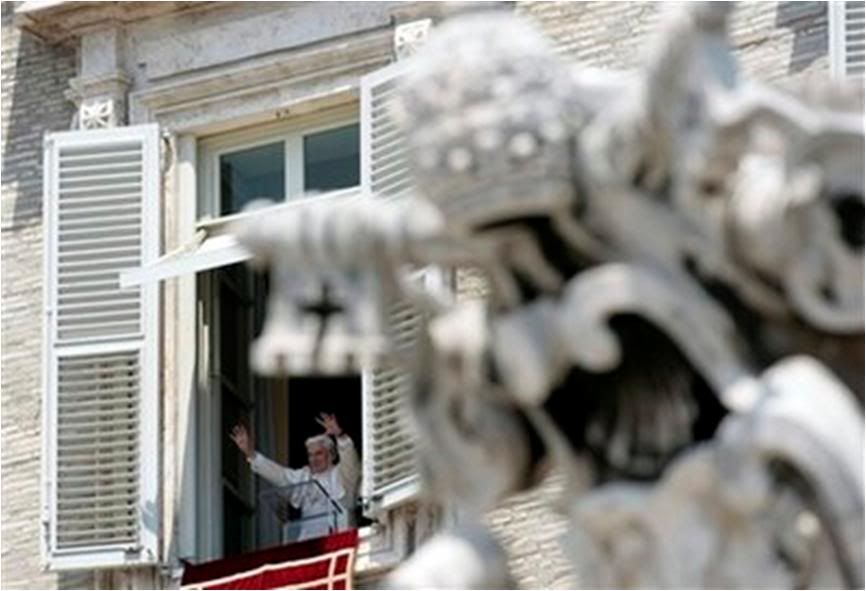
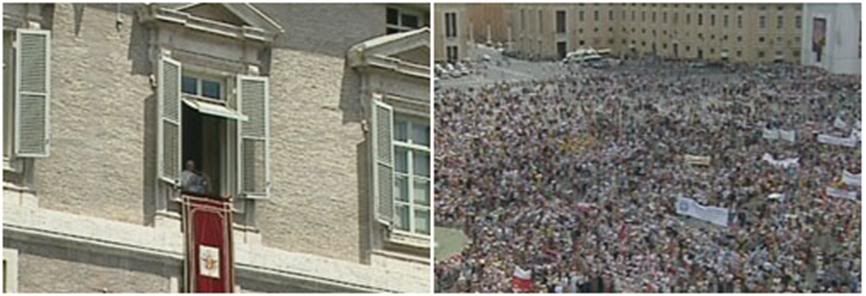 Here is a full translation of the Holy Father's words before the prayers today:
Here is a full translation of the Holy Father's words before the prayers today:
Dear brothers and sisters!
With the celebration of the First Vespers of Saints Peter and Paul which I will preside over this evening at the Basilica of St. Paul outside the Walls, the Pauline Year, which was declared to mark the bimillennary of the birth of the Apostle of the Gentiles, comes to a close.
it has been a true time of grace during which, through pilgrimages, catecheses, numerous publications and diverse initiatives, the figure of St. Paul was re-proposed throughout the entire Church, and his vibrant message revived in all Christian communities a passion for Christ and his Gospel.
Let us therefore give thanks to God for the Pauline Year and for all the spiritual gifts that it has brought us.
Divine Providence saw to it that a few days ago, on June 19, Solemnity of the Sacred heart of Jesus, another special year was inaugurated, the Year for Priests, on the occasion of the anniversary of the death - dies natalis [birthday in heaven] - of Jean-Marie Vianney, the holy curate of Ars.
This is another spiritual and pastoral initiative which, I am sure, will not fail to bring many benefits to the Christian people and especially to the clergy.
What is the purpose of the Year for Priests? As I wrote in the letter I sent to all priests for the occasion, it is meant to help promote a commitment to interior renewal by all priests so that they may give the world today a stronger, more incisive witness to the Gospel.
The apostle Paul constitutes, in this respect, a splendid model to imitate not so much in the concrete details of his life - his was truly extraordinary - but in his love for Christ, in his zeal to announce the Gospel, in his dedication to the community, in his elaboration of effective syntheses of pastoral theology.
St. Paul is the example of a priest who totally identified with his ministry - as the holy Curate of Ars would be - conscious of carrying an inestimable treasure, namely, the message of salvation, but carrying it in a 'vessel of clay' (cfr 2 Cor 4,7).
That is why he is at once strong and humble, intimately convinced that everything is to God's merit, everything is his grace.
"The love of Christ possesses us," the Apostle writes, and this can well be the motto of every priest whom the Spirit has 'compelled' (cfr Acts 20,22). The priest should belong completely to Christ and to the Church, to whom he is called to dedicate himself with undivided love, like a husband faithful to his wife.
Dear friends, together with the holy apostles peter and Paul, let us now invoke the intercession of the Virgin Mary that she may obtain from the Lord abundant blessings for all priests during the Year for Priests that has just begun.
May Our Lady, whom St. Jean Marie Vianney so loved and made his parishioners love, help every priest to revive the gift of God which is in him by virtue of his Holy Ordination, so that he may grow in holiness and be ready to bear witness, to the point of martyrdom if need be, to the beauty of his total and definitive consecration to Christ and to the Church.
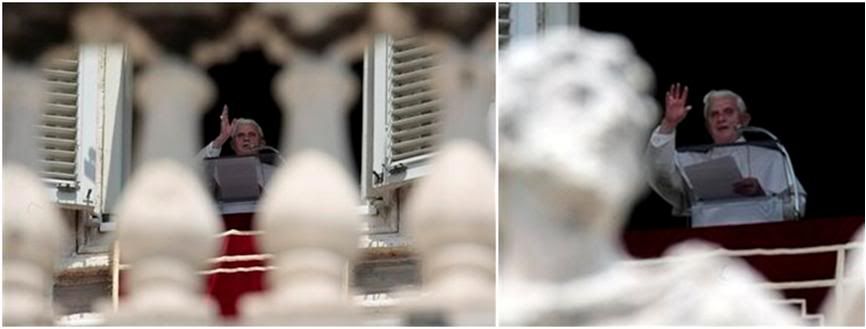
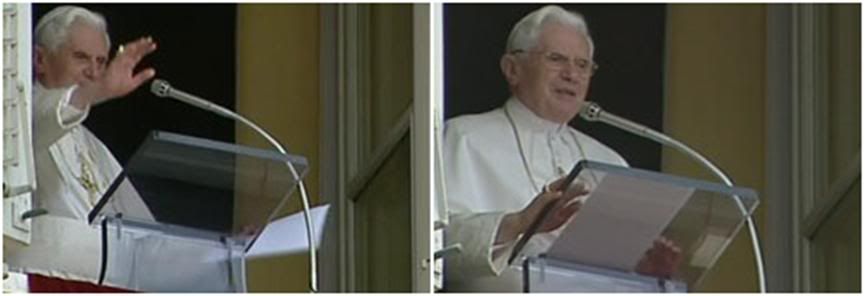
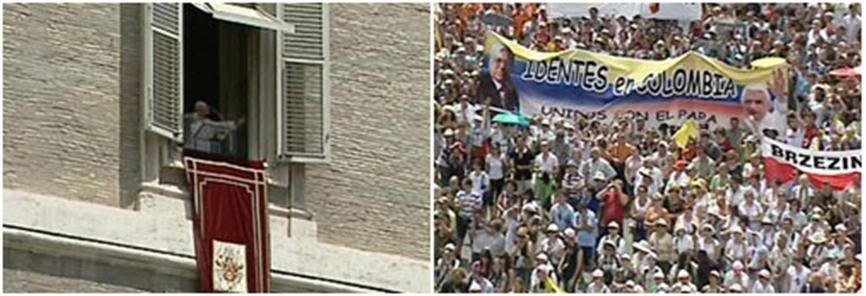
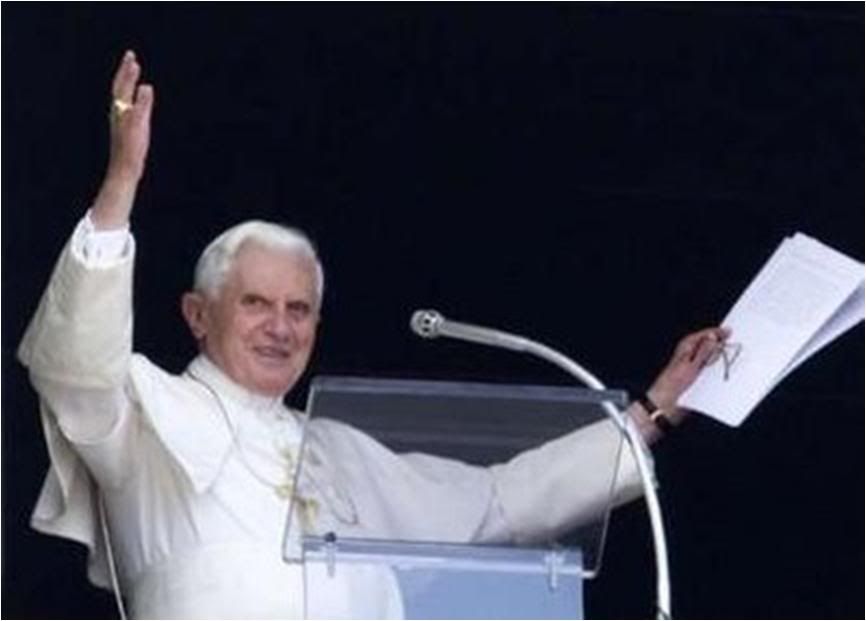
[Modificato da TERESA BENEDETTA 15/07/2009 22:32] |
| |
 28/06/2009 19:19 28/06/2009 19:19 |
|
| | | OFFLINE | | Post: 17.810
Post: 479 | Registrato il: 28/08/2005
Registrato il: 20/01/2009 | Administratore | Utente Senior | |
|

 The Pauline Year ends:
The Pauline Year ends:
Days of expectation
and Curial changes
Translated from
Andrea Tornielli's blog

June 28, 2009
Just hours away from the solemn conclusion of the Pauline Year, which Benedict XVI presides over this evening in the Basilica of St. Paul outside the Walls, L'Osservatore Romano gave great play in its Sunday issue to a most important discovery, which came most unexpectedly on June 19 during restoration of frescoes in the catacombs of St. Tecla on the via Ostiense. [Photos and translated story have been posted in the CHURCH&VATICAN thread]. It is the oldest known image of the Apostle brought to light so far.
In the next few days, before the Pope leaves for Val D'Aosta on his annual summer vacation on July 13, his social encyclical, Caritas in veritate is expected to finally come out. It is about a hundred pages long, dealing with globalization, the current global economic and financial crisis, and the Church's views on how these issues should be dealt with.
Also expected soon is his Motu Proprio that will bring the Pontifical Commission Ecclesia Dei under the wing of the Congregation for the Doctrine of the Faith.
Several Curial nominations are also expected.
- Ecclesia Dei will have a new secretary in Mons. Guido Pozzo, replacing Mons. Mauro Marini who passed away;
- The assignment of Mons. Gabriele Caccia, longtime counsel for general affairs in the Secretariat of State, to be an Apostolic Nuncio;
- His probable replacement at State by the American Mons. Peter Brian Wells, originally from the Diocese of Tulsa, Oklahoma, who has been heading the English section at the Secretariat;
- Mons. Pietro Parolin, who has been deputy 'foreign minister' to Mons. Dominique Mamberti, will also be given an Apostolic Nunciature, possibly in Canada, replacing the present Nuncio who will be sent to Paris.
- The nomination of Mons. Giampaolo Crepaldi, currently secretary of the Pontifical Commission For Justice and Peace, and one of the collaborators in the social encyclical (since his Commission is 'sectorally' responsible for the subject), to be the Bishop of Trieste;
- Mons. Renato Boccardo will relinquish his post as secretary of the Vatican Governatorate to Mons. Carlo Maria Vigano, another high-ranking monsignor being reassigned from the Secretariat of state. Boccardo was earlier thought slated to become the Nuncio in Paris, but it appears he may be named Bishop of Spoleto as part of a round of musical chairs among the Italian bishops.
There is talk of a two-year term extension for three Curial heads who are turning or have just turned 75) - Cardinal Giovanni Batista re (Congregation for Bishops), Cardinal Franc Rode (Institutes of Religious Life), and Claudio Hummes ( Clergy).
The cardinal Secretary of State, Tarcisio Bertone, will also be turning 75 soon, but it is unlikely that the Pope will let his principal co-worker retire early.
[Tornielli does not mention Cardinal Walter Kasper, who also turns - or has turned - 75.]
P.S. Translation alert: A German theologian, who heads the faculty of Catholic Theology at the University of Tuebingen has written an article claiming that the Pope had no right or authority to revoke the excommunication of teh FSSPX bishops. This time, a respected and veteran canonist at the Vatican has promptly replied - that, in effect, the theologian does not know his canon law!
[Modificato da TERESA BENEDETTA 29/06/2009 21:36] |
| |
 28/06/2009 19:37 28/06/2009 19:37 |
|
| | | OFFLINE | | Post: 17.811
Post: 480 | Registrato il: 28/08/2005
Registrato il: 20/01/2009 | Administratore | Utente Senior | |
|
 VESPERS CONCLUDING
VESPERS CONCLUDING
THE YEAR OF ST. PAUL
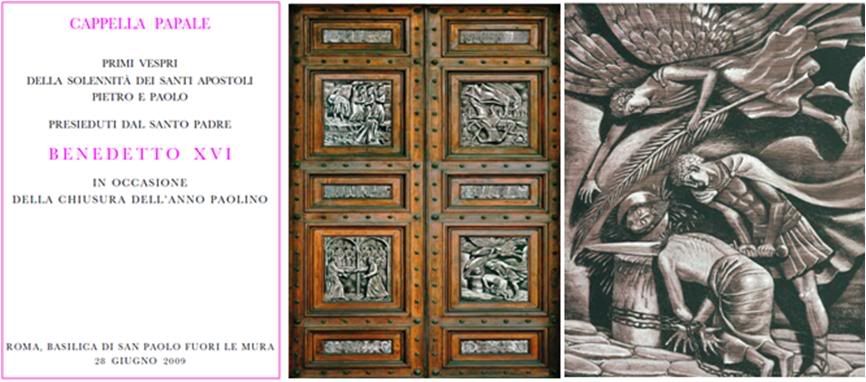 Illustrations: Porta Paolina (Pauline Year door), St. Paul's Basilica. Reliefs by Guido Veroi, 2008. Panel: Beheading of St. Paul.
Illustrations: Porta Paolina (Pauline Year door), St. Paul's Basilica. Reliefs by Guido Veroi, 2008. Panel: Beheading of St. Paul.
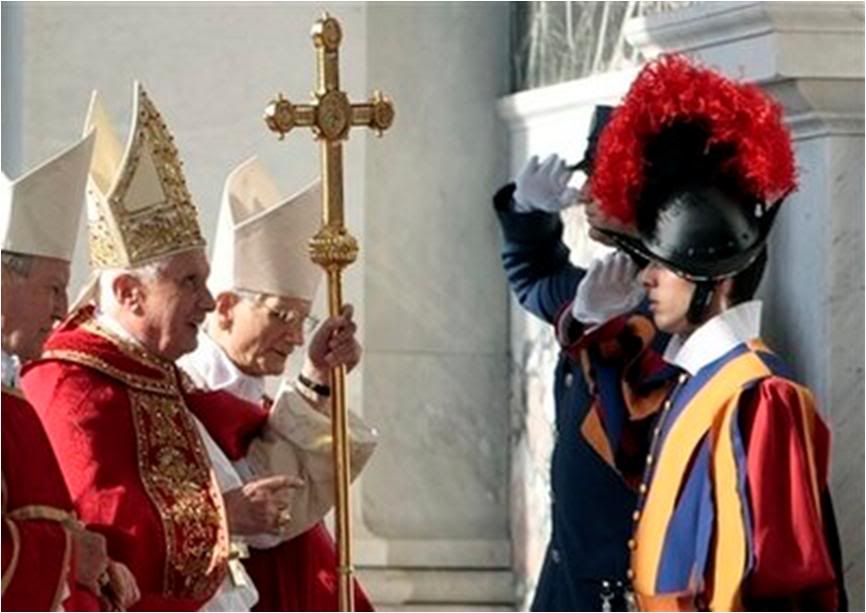


[IMG]http://i601.photobucket.com/albums/tt96/MARITER_7/090628-VESPERS-
MONTAGE-2.jpg[/IMG]
Here is a translation of the Holy Father's homily at First Vespers today:
Eminent Cardinals,
Venerated brothers in the Episcopate and Priesthood,
Distinguished members of tHE delegation from the Ecumenical Patriarchate,
Dear brothers and sisters:
I extend to everyone my heartfelt greeting. In particular, I greet the Cardinal Arch-Priest of this Basilica and his co-workers, I greet the Abbot and the Benedictine monastic community, and I greet the delegation from the Ecumenical patriarchate of Constantinople.
The year commemorating the birth of St. Paul ends tonight. We are gathered at the tomb of the Apostle, whose sarcophagus, preserved under the papal altar, was recently the object of careful scientific studies.
In the sarcophagus, which has never been opened over so many centuries, a very small hole was drilled in order to introduce a special sound which retrieved traces of a precious purple colored fabric with gold sequins, and an azure fabric with linen threads.
Also retrieved were grains of red incense and of protein and bone substances, Moreover, tiny bone fragments subjected to carbon-14 dating by experts who were not told of their provenance were shown to be those of a person who lived in the first or second century [after Christ].
This seems to confirm the unanimous and uncontested tradition that has come to us about the mortal remains of the apostle Paul.
All this fills our hearts with profound emotion. Many persons, during these months, have followed the footsteps of the Apostle - his exterior travels, but more than that, the interior ways that he went through during his life: the road to Damascus and his encounter with the risen Christ; the routes of the Mediterranean world which he traversed with the torch of the Gospel, encountering both contradiction and adherence; and finally, his martyrdom, through which he belongs for always to the Church of Rome. Indeed, he addressed to the Romans his greatest and most important letter.
The Pauline Year ends, but to walk together with Paul, with him and thanks to him, to come to know who Jesus is, as he did, to be illuminated and transformed by the Gospel - this will always be part of Christian existence.
Always, going beyond the circle of believers, he remained the 'teacher of the Gentiles' who brought the message of the Risen One to all men, because Christ knows and loves everyone - he died and resurrected for all of them.
And so we wish to listen to him at this time as we solemnly begin the feast of the two Apostles who were united by a tight bond.
It is part of the structure of Paul's Letters that they - always in reference to a place and a particular situation - explained, first of all, the mystery of Christ - that they teach us the faith.
The next part consisted in its application to our lives: what are the consequences of such faith? How does it shape our day-to-day existence?
In the Letter to the Romans, this second part starts with Chapter 12, in whose first two verses the Apostle quickly sums up the essential nucleus of Christian existence.
What does St. Paul tell us in that passage? First of all he affirms, as a fundamental thing, that a new way of venerating God began with Christ - a new worship. And it consists in that the living man himself becomes adoration, a 'sacrifice' in his own body. It is no longer things that are offered to God. It is our very existence that should become a praise of God.
But how can this take place? The answer is given to us in the second verse: "Do not conform yourselves to this age but be transformed by the renewal of your mind, that you may discern what is the will of God..." (12,2).
The two decisive words in this verse are 'transform' and 'renew'. We must become new men, transformed to a new mode of existence. The world is always in search of something new, because, rightly, it is never satisfied with concrete reality.
Paul tells us: the world cannot be renewed without new men. Only when there are new men will there also be a new world, a renewed and better world.
At the beginning must be man's renewal. This goes for each individual. Only if we ourselves become new can the world become new. This also means that it is not enough to adapt oneself to the present situation. We will return to this point when we reflect on the second text that I wish to meditate upon with you tonight.
The Apostle's NO is clear and even convincing for those who follow the 'schema' [agenda] of our world. How does one renew oneself? Are we really capable of doing so?
With his words about becoming new, Paul alludes to his own conversion: to his encounter with the risen Christ, of which he says in the Second Letter to the Corinthians, "So whoever is in Christ is a new creation: the old things have passed away; behold, new things have come" (5,17).
The meeting with Christ was for him so overwhelming that he said about it: "I died..." (Gal 2,19; cfr Rm 6). He had become a new man, another man, because he no longer lived for himself and for himself, but for Christ and in him.
In the course of years, however, he also saw that this process of renewal and transformation continues for all of one's life. We become new, if we allow ourselves to be possessed and formed by the New Man, Jesus Christ.
He is the New Man par excellence. In him, the new human existence became reality, and we can really become new if we deliver ourselves into his hands and allow ourselves to be formed by him.
Paul makes this process of 're-fusion' even clearer, saying that we become new if we transform our way of thinking. That which we translate here as 'way of thinking' is the Greek term nous. it is a complex word. It can be translated as spirit, sentiment, reason, and precisely, even as 'way of thinking'.
Our very reasoning should become new. This surprises us. We may perhaps have expected that the renewal would apply to an attitude: something in the way we behave that should be changed, a precept of alteration.
But no: renewal must be through and through. Our way of looking at the world, of comprehending reality - all our thinking should change from its very bases.
The thinking of the old 'I', the common way of thinking, is usually concerned with possession, wellbeing, influence, success, fame and the like. But in this way, it has a very limited bearing, and in the ultimate analysis, it is the 'I' who is the center of the world.
We should learn to think more profoundly. And what this means, St. Paul tells in the second part of his sentence: one must learn to grasp the will of God so that it shapes our own will. In order that we ourselves can want what God wants, acknowledging that God wants what is good and what is beautiful.
It is a question therefore of a turnabout in our basic spiritual orientation. God must enter into the horizon of our thinking - what he wants and the way he conceived the world and myself. We must learn to take part in the thought and will of Jesus Christ. Then we will be new men among whom the new world will emerge.
The same thought of a necessary renewal of our essence as humans was further illustrated by Paul in two passages from the Letter to the Ephesians, on which let us reflect briefly. In the fourth chapter of teh letter, the Apostle tells us that with Christ we should reach adulthood, mature manhood. We can no longer "be infants, tossed by waves and swept along by every wind of teaching..." (4,14).
Paul desired that Christians should have a mature faith, 'an adult faith'. The term 'adult faith' has become a widespread slogan in recent decades. One often hears it used to describe the attitude of those who no longer listen to the Church and her Pastors, but autonomously choose that which they want to believe or not to believe - therefore a 'do-it-yourself' faith. And to express oneself against the Magisterium of the Church is presented as 'courage'.
In fact, no courage is needed for this, because one can always be sure of getting public applause. Rather, courage is required to adhere to the faith of the Church even if it contradicts the 'schema' of the contemporary world. It is this non-conformism of faith which Paul calls an 'adult faith'.
On the other hand, he calls it infantile to run with the winds and currents of the time. Therefore, it is part of having 'adult faith', for instance, to commit oneself to the inviolability of human life from the very first moment, thus opposing radically the principle of violence, in defense of the most helpless of human creatures.
It is part of adult faith to recognize marriage between a man and a woman for their whole life as the order of Creation, freshly re-established by Christ.
Adult faith does not allow itself to be carried along willy-nilly by any current. It goes against the winds of fashion. It knows that such winds are not the breath of the Holy Spirit! It knows that the Spirit of God is expressed and manifested in communion with Jesus Christ.
Nonetheless, even in this, Paul does not stop at saying NO, but leads us to the great YES. He describes adult faith, one that is truly adult in a positive way, with the expression: "living the truth in love" (cfr Eph 4,15).
The new way of thinking, given to us by faith, turns first of all to the truth. The power of evil is lies. The power of faith, the power of God, is truth. The truth about the world and about our own selves becomes visible if we look to God. And God is made visible to us in the face of Jesus Christ.
Looking at Christ, we recognize another thing: truth and love are inseparable. In God, both are inseparably one: this is precisely the essence of God. That is why for Christians, truth and love must go together. Love is the test of truth. We must always be measured anew by this criterion in which truth becomes love ,and love makes us truthful.
Yet another important thought appears in St. Paul's verses. The Apostle tells us that by living truth in love, we contribute so that everything - the universe - grows towards Christ.
Paul, on the basis of his faith, was not interested only in our personal rectitude nor with the growth of the Church alone. He is interested in the universe: ta pánta. The ultimate goal of the work of Christ is the universe - the transformation of the universe, of the entire human world, of all creation.
Whoever, with Christ, serves truth in love, contributes to true progress in the world. It is very clear here that Paul knew the idea of progress.
Christ - his life, suffering and resurrection - was the true great leap of progress for mankind, for the world. Now, however, the universe must grow in like measure. There is true progress in the world wherever the presence of Christ increases - because there, man becomes new and therefore the world itself becomes new.
Paul makes the same thing obvious to us from yet another angle. In the third chapter of the Letter to the Ephesians, he speaks of the need to be "strengthened... in the inner self," (3,16). He picks up here a subject that he dealt with, in a situation of tribulation, in his Second Letter to the Corinthians: "...although our outer self is wasting away, our inner self is being renewed day by day" (3,16).
The interior man should reinforce himself - it is an imperative that is very appropriate for our time when men often remain interiorly empty, and so, they must hold on to promises and drugs, which then have the consequence of further increasing their interior sense of emptiness. This interior void - the weakness of the interior man - is one of the great problems of our time.
Interiorness must be reinforced - the perceptiveness of the heart; the capacity to see and understand the world and man from within, with the heart.
We have need of reason illuminated by the heart, in order to learn to act according to truth in love. But this cannot be realized without an intimate relationship with God, without a life of prayer. We have need of an encounter with God, which is given to us in the Sacraments.
But we cannot speak to God in prayer, if we don't allow him to speak first, if we don't listen to him in the words that have been given to us. In this respect, Paul tells us: "That Christ may dwell in your hearts through faith; that you, rooted and grounded in love, may have strength to comprehend with all the holy ones what is the breadth and length and height and depth, and to know the love of Christ that surpasses knowledge" (Eph 3, 17ff).
Love sees much farther than mere reason - that is what Paul is telling us with these words. He also tells us that only in communion with all the saints, that is, only in the great community of all believers - not against or without it - can we know the vastness of the mystery of Christ.
This vastness he circumscribes with words that express the dimensions of the cosmos: breadth, length, height and depth. The mystery of Christ has a cosmic vastness. He does not belong only to a specific group. The crucified Christ embraces the entire universe in all its dimensions. He takes the world in his hands and raises it up to God.
Starting with St. Irenaeus of Lyons - thus, by the end of the second century - the Fathers saw in these words of the breadth, length, height and depth of Christ's love a reference to the Cross.
The love of Christ embraced, on the Cross, the the lowest depths - the night of death - as well as the supreme height - the altitude of God himself. And he took into his arms the breadth and vastness of mankind and the world in all their distances. He always embraces the universe - all of us.
Let us pray the Lord so that he may help us to appreciate something of the vastness of his love. Let us pray to him in order that his love and his truth may move our hearts. Let us ask that Christ may live in our hearts and make us new men who behave according to truth in love. Amen.
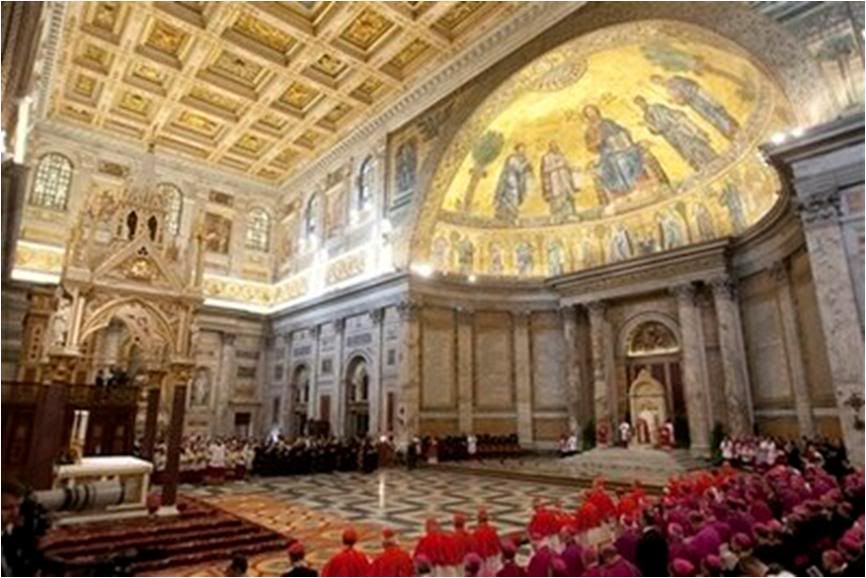

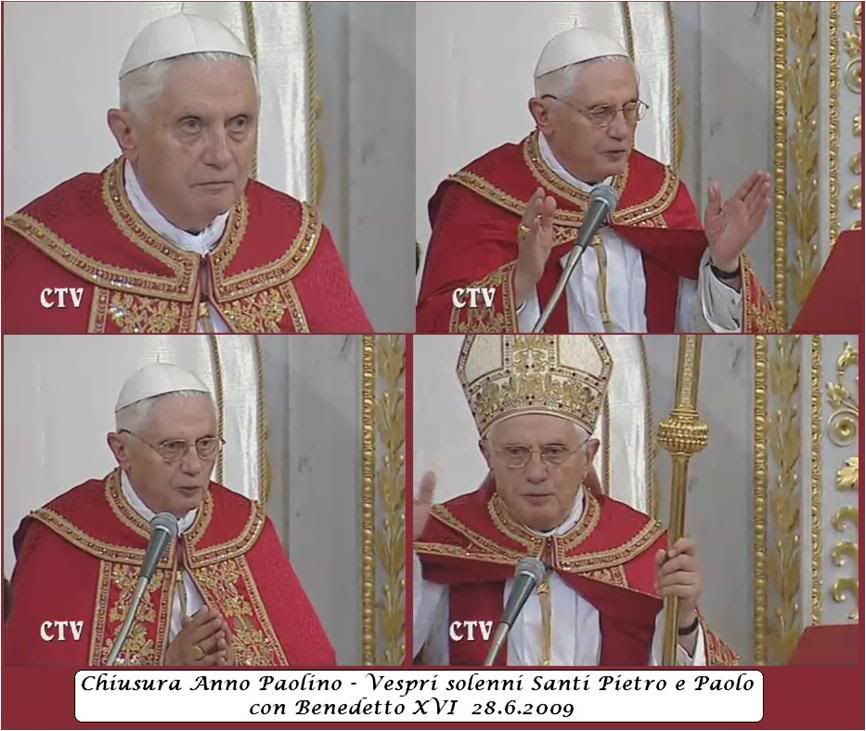
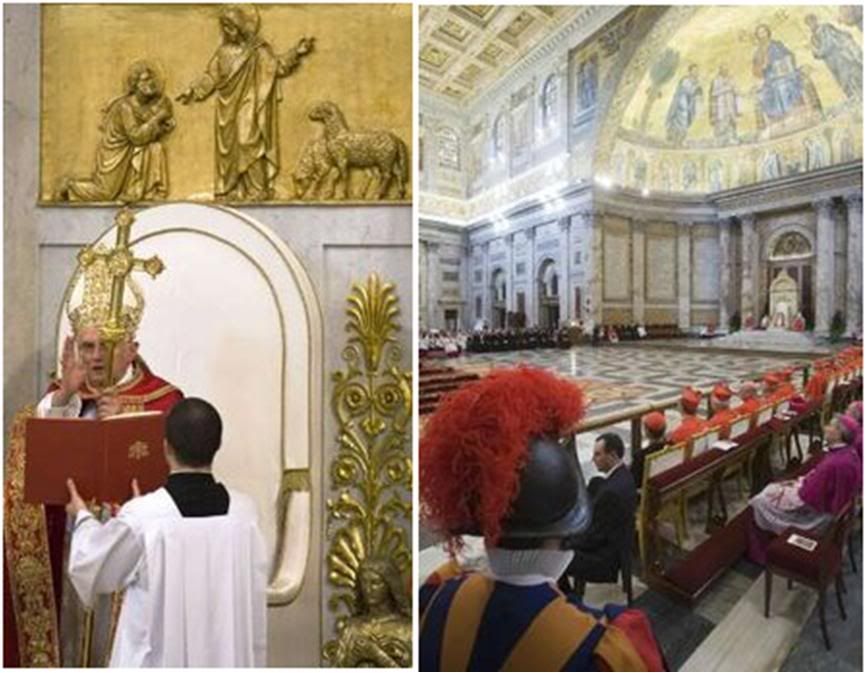 Thanks as usual to Caterina whose prompt montages in the Forum's photogallery are invaluable to supplement the photos taken by the newsphoto agencies.
I had not yet gotten over my euphoria at the portrait of Paul found in the catacombs of St. Tecla [see photos and article in the CHURCH&VATICAN thread), when along omes the Holy Father opening his homily earlier today at St. Paul's Basilica with news about what initial sampling of the interior of Paul's tomb has shown - my jaw fell open as he described the probe and the samples it retrieved!
Thanks as usual to Caterina whose prompt montages in the Forum's photogallery are invaluable to supplement the photos taken by the newsphoto agencies.
I had not yet gotten over my euphoria at the portrait of Paul found in the catacombs of St. Tecla [see photos and article in the CHURCH&VATICAN thread), when along omes the Holy Father opening his homily earlier today at St. Paul's Basilica with news about what initial sampling of the interior of Paul's tomb has shown - my jaw fell open as he described the probe and the samples it retrieved!
I like to see a special association between St. Paul and Benedict XVI. Since he became Pope, the apostle's actual sarcophagus beneath the papal altar at St Paul's was uncovered, the sampling and analysis of the samples from its interior were done, and now the 3rd-4th century portrait! It surely was providential design that the bimillenary year of Paul's birth should take place in Benedict's Pontificate - a jubilee that will not recur for another thousand years! [It was the next best thing to the Jubilee of Christ's birth.]
All of a sudden, St. Paul has taken almost corporeal shape before our eyes - it's almost like feeling his physical presence now in a way one does not expect of any saint from antiquity.
May the Apostle of the Gentiles watch over our Pontiff so that his mission of re-evangelizing the Church while evangelizing the traditional mission lands may succeed. And a special prayer for China that St. Paul may take it under his missionary mantle. Amen.
Although I do not believe Benedict XVI had ever particularly focused on St. Paul before he became Pope, his catecheses about St. Paul have so far filled two published volumes, and some of his most memorable homilies - as the wide-ranging one tonight most certainly was - have been about Paul's laser-like theological insights.
Perhaps eventually, Fr. Schall will write an appreciation of Benedict XVI's floodlit reflections on Pauline thought.
[Modificato da TERESA BENEDETTA 15/07/2009 22:19] |
| |
 29/06/2009 14:33 29/06/2009 14:33 |
|
| | | OFFLINE | | Post: 17.812
Post: 482 | Registrato il: 28/08/2005
Registrato il: 20/01/2009 | Administratore | Utente Senior | |
|

June 29
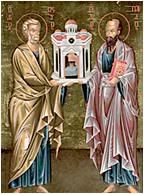 FEAST OF SAINTS PETER AND PAUL
FEAST OF SAINTS PETER AND PAUL
Apostles and Martyrs
No OR today.
THE POPE'S DAY
- Mass at St. Peter's Basilica and Imposition of the Pallium on 35 new metropolitan bishops
- A weekday Angelus, usually held on major religious feasts which fall on a weekday.
[Modificato da TERESA BENEDETTA 29/06/2009 21:52] |
| |
 29/06/2009 14:47 29/06/2009 14:47 |
|
| | | OFFLINE | | Post: 17.813
Post: 483 | Registrato il: 28/08/2005
Registrato il: 20/01/2009 | Administratore | Utente Senior | |
|


 MASS ON THE FEAST
MASS ON THE FEAST
OF SAINTS PETER AND PAUL
AND IMPOSITION OF PALLIUM
ON NEW METROPOLITANS
 Cover: Madonna with the Baby Jesus among Saints Anne, Peter and Paul by Da Pistioa & Dal Corte, 16th-century. Canons' Chapel, Sacristy of St. Peter's Basilica.
Cover: Madonna with the Baby Jesus among Saints Anne, Peter and Paul by Da Pistioa & Dal Corte, 16th-century. Canons' Chapel, Sacristy of St. Peter's Basilica.
At 9:30 this morning, Solemnity of the Holy Apostles Peter and Paul, the Holy Father Benedict XVI presided at a Eucharistic Concelebration in St. Peter's Basilica with 34 Metropolitan Archbishops named within the past year, on whom, in the course of the celebration, the Holy Father conferred on each one a pallium at the Altar of Confession over Peter's tomb.
Following custom on the occasion of the feast celebrating the patron Saints of Rome, a delegation from the Ecumenical Patriarchate of Constantinople was in attendance, led b6 His Eminence Emmanuel, Greek Orthodox Metropolitan of France and director of the Ecumenical Patriarchate's representation at the European Union; His Excellency Athenagoras, Bishop F Synope, and Assistant Metropolitan of Belgium; and the Rev. Deacon Ioakim Billis, from the Patriarchal See, Phanar, in Constantinople.
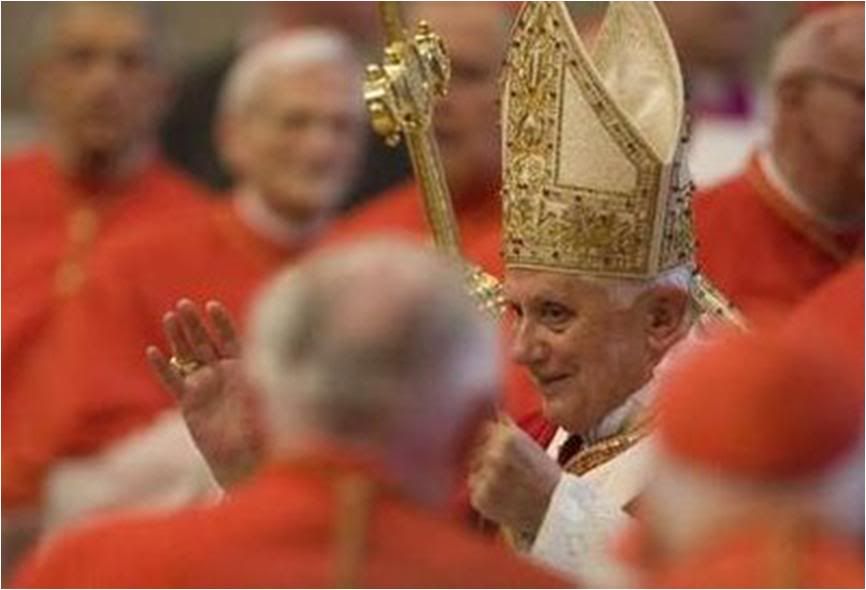


Eminent Cardinals,
Venerated Brothers in the Episcopate and Priesthood,
Dear brothers and sisters:
I address to all my heartfelt greeting with the words of the Apostle near whose tomb we are: "May grace and peace be yours in abundance" (1 Pt 1,2).
I greet particularly the members of the delegation from the Ecumenical Patriarchate of Constantinople and the many Metropolitans who are receiving the pallium today.
In the Collect of this solemn day, we ask the Lord "that the Church may always follow the teaching of the Apostles from which she received the first announcement of the faith".
The request that we raise to the Lord also interpellates us ourselves: Are we following the teaching of the great founding Apostles? Do we really know them?
During the Pauline Year which ended yesterday, we sought to hear him again in a new way - the 'teacher of the Gentiles' - and thus to learn anew the alphabet of the faith. We sought to know Christ with Paul and through him, and in so doing, to find the way for correct Christian living.
In the canon of the New Testament, besides the Letters of St. Paul, there are also two Letters under the name of St. Peter. The first of these letters ends explicitly with a greeting from Rome, although it appears under the apocalyptic cover name of Babylon: "The co-elected one at Babylon sends you greeting..." (5,13).
Calling the Church of Rome the 'co-elected' places her into the community of all local Churches - the community of all whom God has united so that in the Babylon of time in this world, they may construct his People and make God enter into history.
The first Letter of Peter is a greeting from Rome to all of Christianity of all time. It invites us to listen to 'the teaching of the Apostles' which shows us the way to life.
This Letter is a very rich text that comes from the heart and touches the heart. Its center - and how could it be otherwise? - is the figure of Christ, who is described as He who suffers and loves, as the Crucified and Risen One: "When he was insulted, he returned no insult; when he suffered, he did not threaten... By his wounds you have been healed" (1 Pt 2,23ff).
Starting out from the center who is Christ, the Letter also constitutes an introduction to the fundamental Christian sacraments of Baptism and the Eucharist, and a discourse addressed to priests, in which Peter describes himself as a co-'presbyter' with them.
He speaks to the Pastors of all generations as he who was personally named by the Lord to pasture his sheep and therefore, received a priestly mandate in a very special way.
What then does St. Peter tell us - appropriately, in the Year for Priests - about the task of the priest? He calls Christ "pastor and guardian of... souls" (2,25). Where the Italian translation [also the English] uses the word 'guardian', the Greek text uses the word episcopus (bishop).
Farther on, Christ is described as the supreme pastor: archipoimen (5,4). It is surprising that Peter calls Christ himself a bishop - bishop of souls. What did he mean by this?
The Greek word episcopos includes the root for 'to see' - that is why it has been translated as 'guardian', in the sense of 'one who oversees'. Certainly, what is meant is not external guarding as one would in the context of a prison. Rather, what is meant is watching over, from on high - from God's elevation.
Seeing from the perspective of God is seeing with love that wishes to serve another, who wants to help the other become truly himself.
Christ is the 'bishop of souls', Peter tells us. This means: He sees us from the perspective of God. Looking from God's perspective, one has a vision of the whole - one sees the dangers as well as the hopes and possibilities. From the perspective of God, one sees the essence, one sees the man within.
If Christ is the bishop (overseer) of souls, the objective is to prevent man's soul from becoming more impoverished, that man may not lose his essence - the capacity for truth and love. That instead, man may come to know God; that he does not lose his way in dead ends; that he does not end up in isolation but remains open altogether.
Jesus, 'the bishop of souls', is the prototype of every episcopal and priestly ministry. To be a bishop, to be a priest, means in this context: to assume the position of Christ. To think, see and act from the vantage point of his elevation. And starting from him, to be at the disposition of all men so that they may find life.
Thus the word 'bishop' is very close to the word 'pastor', or rather, the two concepts become interchangeable. It is the task of the pastor to pasture and watch over the flock and lead it to the right pastures.
To pasture the flock means to be attentive that the sheep find the right food, that their hunger be satisfied, and that their thirst be slaked.
Beyond metaphor, this means: the Word of God is the nutriment which man needs. Always to make present the Word of God and thus give nutriment to men is the task of the correct pastor.
He should also be able to resist his enemies, the wolves. He should lead and precede, show the way, and keep his flock together.
Peter, in his discourse to the priests, highlights another very important point: It is not enough to speak. pastors should make themselves 'models for the flock" (5,3).
The Word of God is brought from the past to the present when it is lived. It is marvelous to see how in the saints, the Word of God becomes a word that is addressed to our time.
In figures like St. Francis and more recently Padre Pio and many others, Christ has become truly contemporary to their generation. He has emerged from the past to enter into the present.
This is what it means to be a pastor - a model for the flock: live the Word now, in the great community of the holy Church.
Very briefly I would like now to call attention to two other statements in the First Letter of St. Peter which particularly concern us, in our time.
There is, first of all, the sentence, newly rediscovered today, which was the basis upon which the medieval theologians understood their tasks: "Sanctify Christ as Lord in your hearts. Always be ready to give an explanation to anyone who asks you for a reason for your hope" (3,15).
The Christian faith is hope. It opens the way to the future. And it is a hope that has reasonableness" - a hope whose reason we can and should explain.
Faith comes from eternal Reason which has entered our world and has shown us the true God. It goes far beyond the native capacity of our own reason, just as love sees more than mere intelligence.
But faith speaks to reason, and in the dialectical confrontation, it can hold its own against reason. It does not contradict reason, but keeps step with it, while at the same time, leads far beyond reason - to the greater Reason that is God.
As Pastors of our time, we have the task to be the first to understand the reason of faith. The task of not leaving faith to be simply a tradition but to recognize it as the answer to our questions.
Faith demands our rational participation which is deepened and purified in a sharing of love. It is part of our duty as Pastors to penetrate the faith with our thought in order to be able to show the reason for our hope in the disputes of our time.
Nonetheless, thinking, by itself, is not enough. Just as speaking, by itself, is not enough.
In his baptismal and eucharistic catechesis in Chapter 2 of the First letter, Peter refers to the Psalm used by the primitive Church in the context of communion, to this verse: "Learn to savor how good the LORD is" (Ps 34[33],9.
Only 'tasting' [direct experience] leads to seeing. Think of the disciples at Emmaus: it was only during their convivial communion with Jesus, in the breaking of bread, that their eyes were opened.
We become capable of seeing only in an authentic experience of communion with the Lord. This goes for all of us: beyond thinking and speaking, we all need the experience of the faith - that vital relationship with Christ.
Faith should not remain a theory: it should be life. If in the Sacraments, we encounter the Lord, if in prayer we talk to him, if in our day-to-day decisions we adhere to Christ - then we shall always and increasingly 'see' how good he is. Then we can experience how good it is to be with him.
From such a lived certainty comes the capacity to communicate the faith to others in a credible way.
The Curate of Ars was not a great thinker. But he 'tasted' the Lord. He lived with him in the minutiae of every day as in the great demands of the pastoral ministry. This way he became 'one who sees'. He had 'tasted' and so he knew that the Lord is good.
Let us pray the Lord so that he may give us this capacity to 'taste' and that we may become credible witnesses for the hope that is in us.
Finally, I wish to note another small but important statement from St. Peter. Soon after the opening of the Letter, he tells us that the goal of our faith is the salvation of souls )cfr 1,9). In the language and thought of Christianity today, this seems like a strange statement, and for some, even outright scandalous.
The word 'soul' has fallen into discredit. It is said that its use would lead to the division of man unto spiritual and physical, soul and body, whereas in fact, he is an indivisible unity.
Besides, the 'salvation of souls' as a goal of the faith would seem to suggest an individualistic Christianity, a loss of responsibility for the world as a whole, in its corporeality and its materiality.
But none of that is found in the letter of St. Peter. Zeal in bearing witness to hope and responsibility for others characterize the entire text.
To understand the statement about the salvation of souls being the goal of the faith, we must begin from another side. It remains true that lack of attention to souls and the progressive impoverishment of the interior man, not only destroy the individual but threaten the destiny of mankind as a whole.
Without healing souls, without healing man from within, there cannot be salvation of mankind. The true illness of souls is what St. Peter calls ignorance, that is, non-knowledge of God. He who does not know God, who does not at least seek him sincerely, remains outside of true life (cfr 1 Pt 1,14).
Yet another sentence from Peter's Letter can be useful to us in order to better understand the expression 'salvation of souls': "Purify yourselves by obedience to the truth" (cfr 1,,22).
It is obedience to the truth that makes the soul pure. And it is living with lies that contaminates it. Obedience to the truth starts with the small truths of everyday, which may often be difficult and painful.
This obedience extends up to the obedience without reservations to the Truth itself which is Christ. Such obedience does not just make us pure, but above all, it makes us free to render service to Christ and therefore to the salvation of the world, which must always start from the obedient purification of one's own soul through the truth.
We can show the way to truth only if we ourselves - in obedience and patience - allow ourselves to be purified by the truth.
And now let me address myself to you, dear brothers in the Episcopate, who will shortly receive the pallium from my hands. It was woven from the wool of lambs that the Pope blessed on the Feast of St. Agnes.
In this way, it recalls Christ's lambs and sheep whom the risen Lord had entrusted to peter with the task of pasturing them (cfr Jn 21,15-16). It recalls teh flock of Jesus Christ which you, dear brothers, must pasture in communion with Peter.
We are reminded of this by Christ himself, who as the Good Shepherd, has taken upon his shoulders the lost sheep, mankind, in order to bring it back home. It reminds us that He, the supreme Pastor, wanted to be the lamb himself, in order to take charge from within of the destiny of all of us; in order to carry us and heal us from within.
Let us pray the Lord so that he may grant us to follow in his footsteps as just pastors, "not by constraint but willingly, as God would have it...eagerly - examples to the flock" (1 Pt 5,2f). Amen.
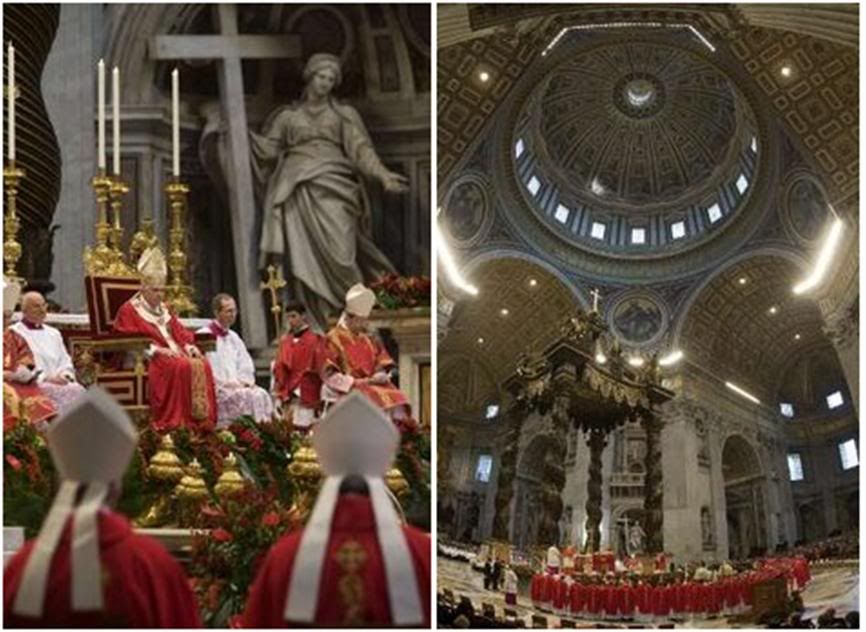




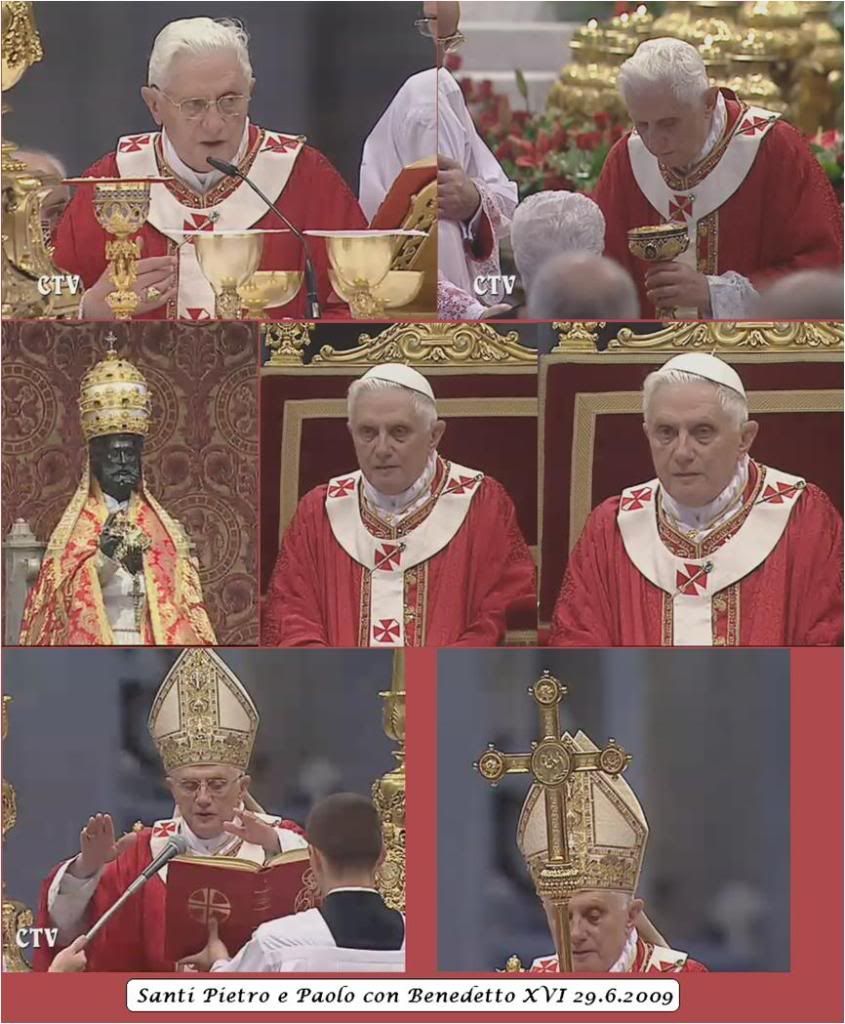 Again, thanks to Caterina without whom the photo roundup of the event would not include anything of the Liturgy of the Eucharist!
Again, thanks to Caterina without whom the photo roundup of the event would not include anything of the Liturgy of the Eucharist!
 Benedict XVI seems able to ramp up his homiletic powers infinitely - even if he has always 'operated' at peak excellence.
Benedict XVI seems able to ramp up his homiletic powers infinitely - even if he has always 'operated' at peak excellence.
His back-to-back homilies on St. Paul and St. Peter - each based on some points for reflection from a letter by each Apostle - are new masterpieces to add to quite a number from his pen in the past few months.
Many of these are in the genre of reminding priests and bishops that they must be truly men of God - and therefore men of prayer - first of all so that they can truly serve their fellowmen and the Church best. A message this Pope has never tired of hammering home, and each time in fresh ways. And often enough, that by late 2007, a curial monsignor was able to publish a collection of Benedict's various discourses about the priesthood in a book called Cari Sacerdoti (Dear priests). Not to mention the Vatican publications this month to mark the start of the Year for Priests.
Before April 19,2005, I had never imagined I would one day read writings on Catholicism in any focused way - or even be interested in doing so, as I felt rather smugly very fortunate to have been 'born and raised in the faith', so I never felt I needed to reinforce it. All I had ever read of the sort had been limited to tbe books of Fulton Sheen decades ago!
Then along comes this highly intellectual but superbly communicative Pope who not only presents the essentials of Catholicism in the most pleasurable ways but also keeps uncovering new and fascinating things about it for me.
He chips away skillfully like a Michelangelo at any superfluities to reveal and polish ever new facets in the diamond of Christian doctrine - and the essence of the faith emerges coruscating and laser-sharp.
I almost regret it when my day job or necessary chores do not enable me, as today, to proceed to translating his homilies or discourses right away. It's been a great and unprecedented experience for me - a genuine spiritual high each time - because in translating, I am better able to appreciate, savor and assimilate his teaching. Translation somehow enables me to get into his thought flow, as it were - it's never just simply translating the words accurately and getting their sense right - and I delight not only in the content of what he says but in the way he develops it.
Above and beyond the intellectual and mental adventure he launches me on is the spiritual enrichment that he makes possible, the effortless widening of reason that he facilitates.
Among so many other things, thank you for this, Heilige Vater!
BENEDICTUS QUI VENIT IN NOMINE DOMINI!
[Modificato da TERESA BENEDETTA 30/06/2009 11:57] |
| |
 29/06/2009 15:35 29/06/2009 15:35 |
|
| | | OFFLINE | | Post: 17.814
Post: 484 | Registrato il: 28/08/2005
Registrato il: 20/01/2009 | Administratore | Utente Senior | |
|


 At the Angelus today,
At the Angelus today,
Benedict XVI announces
he has signed Encyclical #3
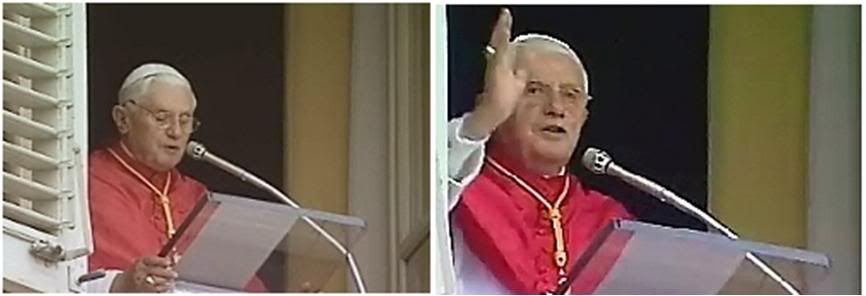
Right after the Angelus prayer today (a holiday appearance by the Pope on the Feast of Saints Peter and Paul, patrons of Rome), the Holy Father said this (translated from the Italian):
My third encyclical which is entitled Caritas in veritate will be published soon. Taking up the social themes contained in Populorum progressio, written by the Servant of God Paul VI in 1967, this document - which carries today's date, June 29, solemnity of the holy Apostles Peter and Paul - aims to analyze in depth some aspects of development that are integral to our time, in the light of love in truth.
I entrust to your prayers this additional contribution that the Church offers mankind in its commitment to sustainable progress in full respect of human dignity and the real demands of everyone.
Here is a translation of the Holy Father's words before leading the Angelus prayers at St. Peter's Square at noon today:
Dear brothers and sisters!
Today we solemnly celebrate the holy Apostles Peter and Pail, special patrons of the Church of Rome: Peter, the fisherman from Galilee, who 'first among all confessed faith in Christ... and constituted the first (Christian) community with the just men of Israel"; Paul, ex-persecutor of Christians "who illuminated the depths of mystery ... the teacher and doctor of the Church who announced salvation to all men" (cfr Preface of today's Mass).
In one of his homilies to the community of Rome, Pope St. Leo the Great said: "These are your fathers and true pastors, who established you so that you may become part of the Kingdom of heaven" (Sermo I,
Nat. App Petri et Pauli, c I, PL 54,422).
On the occasion of this feast, I wish to address a warm and special greeting, along with my fervent wishes, to the diocesan community of Rome that Divine Providence has entrusted to my care as successor of the Apostle Peter.
It is a greeting I gladly extend to all the residents of our metropolis, and to the pilgrims and tourists who are visiting us these days, which also coincide with the closing of the Pauline Year.
Dear brothers and sisters, may the Lord bless and protect you through the intercession of Saints Peter and Paul! As your Pastor, I call on you to remain faithful to the Christian calling and not to conform yourselves to the mentality of this world - as the Apostle of the Gentiles wrote precisely to the Christians of Rome - but let yourself be transformed and renewed by the Gospel so that you may follow that which is truly good and pleasing to God (cfr Rm 12,2).
I constantly pray so that Rome may keep its Christian calling alive, not only to conserve unaltered its immense spiritual and cultural patrimony, but also in order that its inhabitants may translate the beauty of the faith they have received in concrete ways of thinking and acting, thus offering to those who come to our city for various reasons, a climate rich in humanity and evangelical values.
Thus, with the words of St. Peter - I invite you, dear brothers and sisters who are disciples of Christ, to be 'living stones' solidly around him who is "the living stone, rejected by men, but chosen adn precious before God" (cfr 1 Pt 2,4).
Today's solemnity also has a universal character: it expresses teh unity and catholicity of the Church. That is why, every year. on this date, the new Metropolitan Archbishops come to Rome to receive the pallium, symbol of their communion with the Successor of Peter.
I renew my greeting to my brothers in the Episcopate for whom I performed the gesture [of imposing the pallium] at the Basilica this morning, and to the faithful who accompanied them here.
I also renew my heartfelt greeting to the delegation of the Patriarchate of Constantinople who, as every year, have come to Rome for the celebration of Saints Peter and Paul.
May the common veneration for these martyrs be a token of ever more fuller and deeply felt communion among Christians in every part of the world. For this, let us invoke the intercession of Mary, Mother of the only Church of Christ, with our recital of the Angelus.
Pope has signed new encyclical

VATICAN CITY, June 29 (AP) – Pope Benedict XVI signed his latest encyclical Monday, a text on ways to make globalization more attentive to meeting the needs of the poor amid the worldwide financial crisis.
The document, entitled "Charity in Truth," is expected to be published soon.
The Pope has said his third encyclical will outline the goals and values that the faithful must defend to ensure solidarity among all peoples.
Benedict has frequently spoken out on the financial crisis, urging leaders to ensure the world's poor don't end up bearing the brunt of the downturn even though they are not responsible for it. He has said the downturn shows the need to rethink the whole global financial system.
The Pontiff announced he had signed the document Monday, a major Catholic feast day, after celebrating a Mass during which he told new archbishops they must be models for the faithful, guiding them and protecting them as shepherds care for their flock.
Thirty-four new archbishops, including the new archbishop of New York, Monsignor Timothy Dolan, received the pallium, a band of white wool decorated with black crosses that is a sign of pastoral authority and a symbol of the archbishops' bond with the pope.
Benedict said the archbishops should be like Christ "who as a good shepherd carried on his back humanity — the lost sheep — to bring them home."
Benedict has been working on Caritas in veritate, as the encyclical is known in Latin, since 2007 ,but held back on issuing it so that he could update it to reflect the global economic crisis.
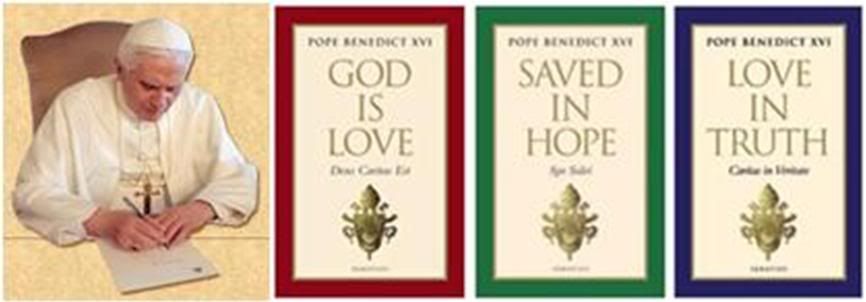
An encyclical is the most authoritative document a Pope can issue. Benedict has written two in his four years as Pope: "God is Love" in 2006 and "Saved by Hope" in 2007.
 Here is the take of the Times of London on the timing of the encyclical release. The timing worked out the way it did because of various delays but one must say it has turned out to be providential:
Pope holds back encyclical
Here is the take of the Times of London on the timing of the encyclical release. The timing worked out the way it did because of various delays but one must say it has turned out to be providential:
Pope holds back encyclical
on markets and morality
to hit the G8 summit
by Richard Owen in Rome and
Ruth Gledhill, Religion Correspondent

The Pope has held back publication of a key statement on markets and morality in an attempt to force the issue onto the G8 agenda.
Pope Benedict XVI signed the document today but the text, which focuses on globalisation, poverty and the financial crisis and is one of the most important to come out of the Holy See in the past decade, will be published 48 hours before the meeting of world leaders at L'Aquila in Italy - a week-long delay.
Caritas in veritate, Love or charity in truth, will outline the ethical values that the faithful must "tirelessly defend" to ensure "true freedom and solidarity", the Pope said recently.
He said that the global downturn demonstrated the need to "rethink economic and financial paradigms that have been dominant in recent years."
The encyclical - the most authoritative document a Pope can issue - analyses the destructive effect on society of the pursuit of commercial or private interests without "social responsibility" or "conscience and honesty".
It proposes an international agreement on globalisation based on "the principles of subsidiarity and solidarity" and "the values of charity and truth".
The Pope has been working on the encyclical for two years, but delayed it in order to bring it up to date and reflect the global economic crisis. Its publication has been further delayed by translation problems into Latin, according to the Italian newspaper La Repubblica.
Although Pope Benedict has encouraged a return to Latin in the liturgy, there is a dwindling number of experts able to find Latin equivalents for terms such as "market value" and "tax haven".
Benedict has written two previous encyclicals in his four years as Pope, Deus caritas est (God is Love) in 2006 and Spe salvi (Saved by Hope) in 2007.
This encyclical will be the first written with the help of Google. Theologians have done months of research on the internet to ensure that the new document, likely to be among the most important and influential of the present papacy, is up to date with its economics as well as its theology.
The long-awaited encyclical also summarises the Church’s 120-year history of social teaching and outlines new theories for the present situation.
While not backtracking on the basic Catholic teaching that man should have the freedom to create wealth, the encyclical is likely to argue forcefully that this should be used towards the service of all.
 And here's an Economics-101 background that may come in useful when the encyclical does come out:
Economic heresies of the left
And here's an Economics-101 background that may come in useful when the encyclical does come out:
Economic heresies of the left
by Michael Novak

June 29, 2009
What exactly is in Benedict XVI’s new encyclical on the economy and labor issues is not yet known. Catholic leftists and progressives, though, are already trembling with excitement. Three glaring errors have already appeared in these heavily panting anticipations.
An accurate presentation of real existing capitalism requires at least three modest affirmations:
1) Markets work well only within a system of law, and only according to well-marked-out rules of the game; unregulated markets are a figment of imagination.
2) In actual capitalist practice, the love of creativity, invention, and groundbreaking enterprise are far more powerful than motives of greed.
3) The fundamental systemic motive infusing the spirit of capitalism is the imperative to liberate the world’s poor from the premodern ubiquity of grinding poverty. This motive lay at the heart of Adam Smith’s important victory over Thomas Malthus concerning the coming affluence — rather than starvation — of the poor.
Since the origins of modern capitalism around 1780, more than two-thirds of the world’s population has moved out of poverty. In China and India alone, more than 500 million have been raised out of poverty just in the last forty years.
In almost every nation the average life expectancy has risen dramatically, causing populations to expand accordingly. Health in almost every dimension has been improved, and literacy has been carried to remote places it never reached before.
Whatever the motives of individuals, the system has improved the plight of the poor as none ever has before. The contemporary left systematically refuses to face these undeniable facts.
Fr. Thomas Reese, S.J., one of our most reliable leftist bellwethers, has recently opined that Benedict XVI’s new encyclical will cry out for more regulation, rather than unregulated markets. Further, the pope will denounce greed and cry out for more attention to the urgent need to aid the world’s poor.
Reese thinks these are anti-capitalist positions. That is ridiculous. They lie at the heart of why capitalism has worked as well as it has to liberate the poor — first in the United States and Europe, then in one continent after another, as it is now doing in almost all areas of Asia.
Fr. Reese says that the Pope will blame the greed of U.S. bankers for the current global financial crisis. While many institutions, including banks, failed in their basic duties, government action was the principal villain in the 2009 debacle.
It was the federal government that forced banks to make sub-prime loans to poor families (who were known to be unable to pay their mortgages on a regular basis). It threatened banks that did not invest in poisonous packages of mortgages, vitiated by the bad ones.
The federal government even guaranteed the work of two huge quasi-government mortgage companies — Fanny Mae and Freddy Mac — that wrote more than half of all mortgages during the fateful years. Of course, when the house of cards fell, government was not there to make good on its guarantees — or even to accept responsibility for its own heavy-handed actions.
For at least ten years before the disaster finally occurred, my colleagues at the American Enterprise Institute had been warning of the government abuses that were heading toward this calamity. Partisans of big government refused to listen.
For moralists, it is essential to see how often (not always) government itself sins grievously against the common good, out of a lust for power and domination over others. Furthermore, government often (not always) generates foolish and destructive regulations, and often dispenses justice that winks rather than justice that is blind.
Government is more frequently the agent of injuring the common good than the ordinary lawful actions of free citizens. During the twentieth century, governments too often destroyed the common good of their citizens for years to come.
In the United States, the existing code of federal regulations for businesses is enormous. Title 12 covering “Banks and Banking” runs to 4,786 pages; Title 15 on “commerce and Foreign Trade” is 1,941 pages; Title 16 on “Commercial Practices,” 1,600 pages; Title 17 on the “Securities and Exchange Commission,” 2,708 pages; and Title 31 on “Money and Finance: Treasury,” 1,917 pages.
The total number of pages in this code is 12,592. Laid out end to end, the volumes of the code extend for 2.35 miles. If you count the pages in feet (30 inches per linear foot is the standard measure) the code runs for six linear miles.
An unregulated market indeed! The real world of American capitalism is more like Gulliver bound down by thousands of threads. Many of the regulations are out of date, obsolete, costly, destructive, and — in their actual effects — counter to the very intentions that gave them birth. But regulation there is, and regulation there must be. Without rules, American capitalism cannot function.
As for greed, Max Weber pointed out that greed is present in every age and every system of human history. Yet greed was rather more socially central in ancient times than today, and played a much more decisive role. And nowadays, greed flourishes most wherever government power is concentrated.
By contrast, in enterprise societies such as the United States, it is possible to become rich — even very rich — by methods that focus on innovation rather than greed.
The great universities of the Middle West and Far West, were founded expressly to give spur to new inventions in mining, agriculture, and other technical fields. Texas A & M, Iowa State, Wisconsin State, Oklahoma State, and scores of others have been the hothouses of ideas in agriculture, engineering and electronics, geology, mining and drilling—ideas rendered practical by the makers of many fortunes. They have mightily served the common good of Americans and the entire human race.
As John Paul II wisely commented in Centesimus Annus, practical knowledge is the main cause of wealth today. Ideas rather than great landholdings are the main form of wealth in our time. As both Caesar and Cicero long ago observed, although it seems as though community ownership ought to serve the common good best, in practice private property does. The right to private property has long been justified by virtue of its superior service to the common good.
And in the United States, scores of entrepreneurs are ready to risk losing everything they have in order to create something new, create something that will make life better for their fellow men. Henry Ford failed repeatedly in several businesses before he finally made the Ford Motor Company the great model for business that it once was.
(It was the first establishment in history to pay its laborers a handsome wage of five dollars per day. At the time, ordinary lawyers averaged about $1500 per year. Ford’s motives, of course, were not altruistic; he wanted his workers to purchase the cars they helped build.)
As Oscar Handlin once noted, almost every industrialist who built a new railroad North and South in the United States in the nineteenth century prospered. Nearly every tycoon who tried to build an East–West railroad lost money. What spurred men to keep trying had less to do with greed that with the sheer romance of conquering the deserts and the Rockies. The element of romance in business is simply not grasped by dialectical materialists.
In brief, nearly all the leftish critiques of American and other forms of capitalism are empirically false. They do not fit the actual facts. But these three — greed, unregulated markets, and the idea that capitalism makes the poor of the world worse off — are especially tiresome, and very far from reality.
Will all those good Catholic leftists who announce their own enthusiastic preference for the poor actually help to liberate the poor, even by a little? Will their anti-capitalist policies help alleviate poverty? The historical record offers very little evidence for that contention.
And yet wherever a healthy, inventive capitalism goes, the poor soon rise by the millions out of poverty, come to better physical health, and advance into higher education.
You can look up the record.
[Modificato da TERESA BENEDETTA 15/07/2009 21:59] |
| |
 30/06/2009 02:13 30/06/2009 02:13 |
|
| | | OFFLINE | | Post: 17.815
Post: 485 | Registrato il: 28/08/2005
Registrato il: 20/01/2009 | Administratore | Utente Senior | |
|

 New archbishops say the pallium represents
New archbishops say the pallium represents
their ties to the Pope and to their parishioners
By Carol Glatz

VATICAN CITY, June 29 (CNS) -- Receiving the woolen pallium from the pope underlines an archbishop's unique ties to the vicar of Christ in Rome and to his own flock of parishioners back home, said a number of archbishops from the United States and Canada.
The pallium "strikes me as somewhat of a wedding ring -- that we are intimately bound to our people -- our sheep -- as shepherds," said Archbishop Timothy M. Dolan of New York, "and we're also bound to the universal Pastor of the church, Pope Benedict XVI."
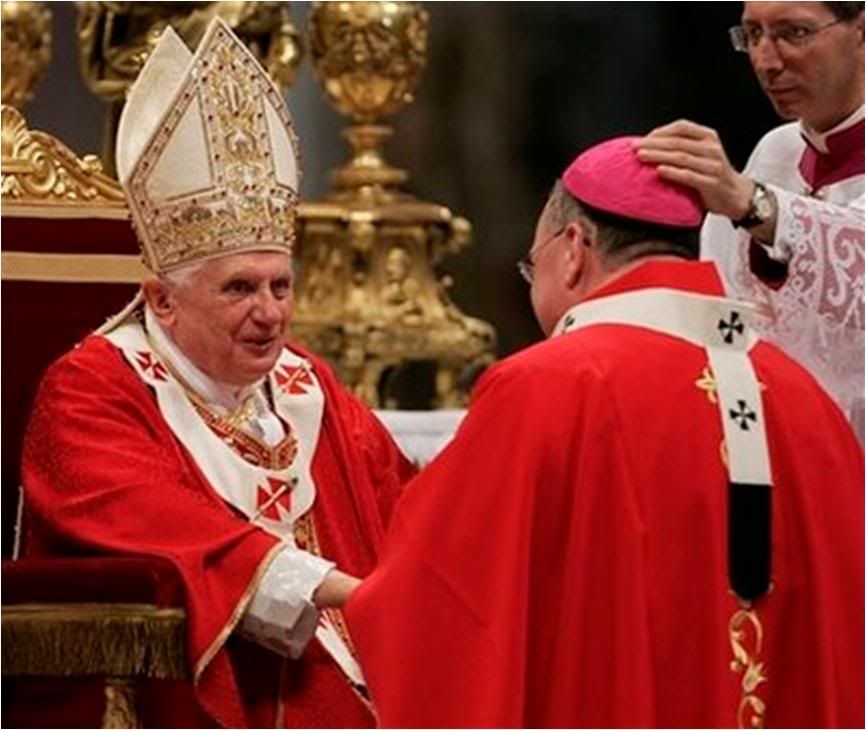
Archbishop Dolan was one of 34 bishops from 20 countries who received the white, narrow circular band called a pallium during a special Mass in St. Peter's Basilica June 29. He and four other U.S. archbishops spoke to reporters after the ceremony.
Archbishop Gregory M. Aymond of New Orleans said it was "a very powerful experience" to see the tremendous diversity and universality of the Catholic Church during the ceremony.

After the Pope gently placed the woolen band over his shoulders, it was very moving "to have that connectedness with the Holy Father wearing a pallium similar to his," said the New Orleans native.
"And to have that opportunity again to pledge loyalty and obedience and respect to (the Pope) as the Vicar of Christ is a powerful and touching event," he said.
Archbishop Allen H. Vigneron of Detroit said the ceremony made Jesus's words in the Gospel of John, "I am the vine, you are the branches," come alive.
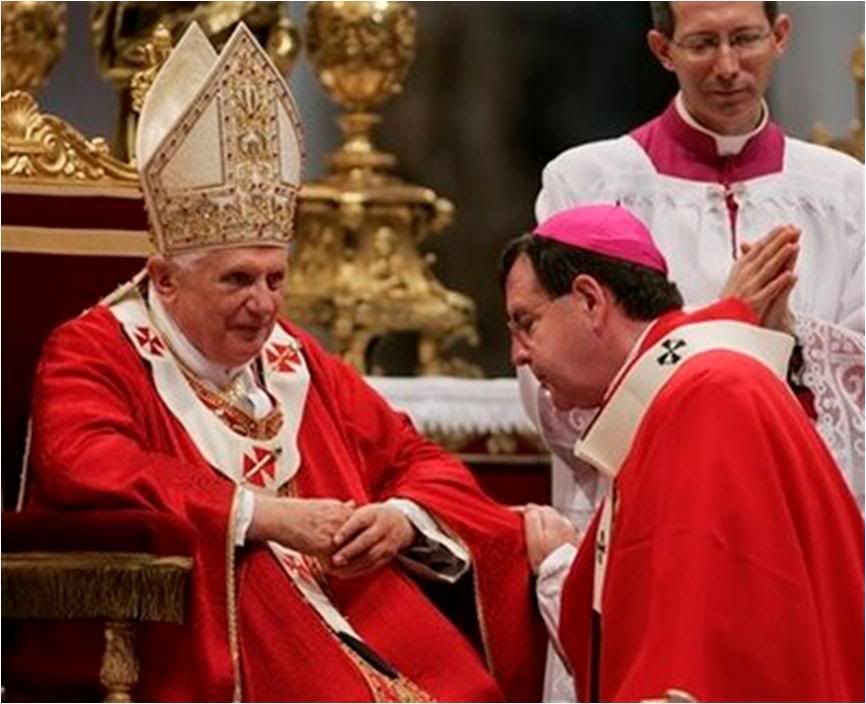
Taking part in the intimate ceremony with the Pope underlined "this profound sense of the living, organic reality of the Church; that Peter isn't an idea, Peter continues to live in the presence of the Pope" thorough "a living chain," he said.
He said he saw the many different ways members of the universal Church are connected to one another and that he was grateful "to belong to the same family as Sts. Peter and Paul and do some of their same work."
Archbishop George J. Lucas of Omaha, Neb., said it felt like a dream to be able to celebrate the June 29 feast of Sts. Peter and Paul above the tomb of St. Peter and receive the pallium and blessings from the Pope and to feel such solidarity with him.

Archbishop Lucas said he was praying he would have the same "kind of pastoral effect that I think the Holy Father has on all of us in the Church."
He said he sees the Pope as being "a very benevolent pastor" and he would like to imitate and share that quality with the people in his new archdiocese.
Archbishop Robert J. Carlson of St. Louis said this was his 25th year as a bishop and that St. Louis would be his fourth diocese.
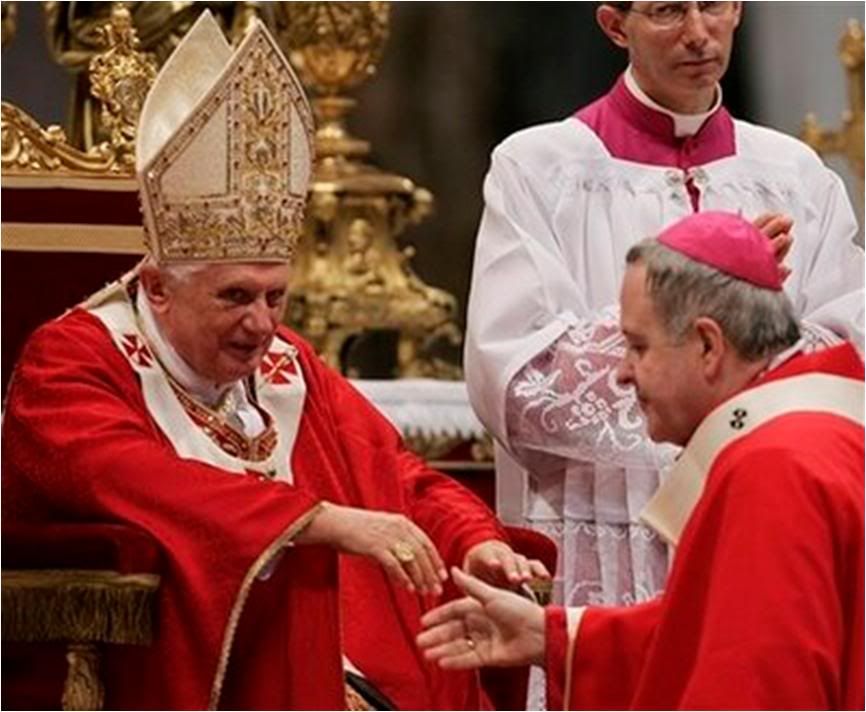
"I've had a really hard time holding down a job," he joked. But he said he has been blessed with meeting and working with so many wonderful people over the years "who have touched me so deeply."
He said the Mass was "a deeply moving experience of faith for me" and that it gave him an opportunity to reflect on the faith of the people in St. Louis and how privileged he feels to be there.
Many of the archbishops were accompanied by a dozen or hundreds of friends, family and faithful for the pilgrimage to Rome.
The pastors found many opportunities to pray and celebrate with their pilgrims.
Archbishop Vigneron said when Catholics come to Rome they often get a sense that Rome is their city, too.
"Romans are generally quite good at that: they have this city as a kind of trust and that anybody who belongs to the Church has kind of a citizenship in Rome and I think that's a beautiful experience," he said.
Canadian Archbishops Pierre-Andre Fournier of Rimouski, Quebec, and J. Michael Miller of Vancouver, British Colombia, also received their palliums June 29.
They led their pilgrims on a private tour of the Sistine Chapel and shared a brief prayer with them there June 27.
Archbishop Miller told Catholic News Service during the chapel tour that he was traveling with pilgrims from Vancouver and Texas, where he served as president of the University of St. Thomas in Houston from 1997-2004.
Having the faithful accompany a bishop "is wonderful" because it is "a sign of being a shepherd with members of our flock. For them it is a moment when they are linked through their bishops to the Pope," he said.
Archbishop Miller also said that for him the pallium is "a sign that my burden is light -- it's not all heaviness. It's also a reminder that as shepherds we need to go where the sheep gather, those who have wandered, those who are not practicing their faith. We need to find them and bring them back."
Archbishop Fournier said it was very meaningful for him to receive his pallium on the same day Pope Benedict was signing his first social encyclical because the symbolism of the pallium "is carrying around my shoulders the sheep, especially the poor."
He said he depends on Christ's love in order to handle the responsibilities of being a bishop. "You can go through everything if you focus on his love," he said, adding it is Christ who really wears the pallium, carrying his flock and his disciples.
|
| |
 30/06/2009 12:40 30/06/2009 12:40 |
|
| | | OFFLINE | | Post: 17.816
Post: 486 | Registrato il: 28/08/2005
Registrato il: 20/01/2009 | Administratore | Utente Senior | |
|

June 30
 First Christian Martyrs
First Christian Martyrs
of the Church of Rome
Died 64-68 AD under Emperor Nero
No OR today.
THE POPE'S DAY
An exception to the 'no audiences on Tuesday' norm:
The Holy Father had a special aduience at the Aula Paolo VI thoday for teh 34 new metropolitan archbishops
who received their pallium yesterday, and their families,friends and diocesan faithful who accompanied them
to Rome. Plurilingual address.
PRESENTING THE RESTORED
PAULINE CHAPEL
The Governor of Vatican State, Cardinal Giovanni Lajolo, held a news conference today to present
the newly-restored Pauline Chapel in the Apostolic Palace, seven years after restoration work began.
It includes two of Michelangelo's last known paintings. The Holy Father will bless the restored chapel
on July 4.
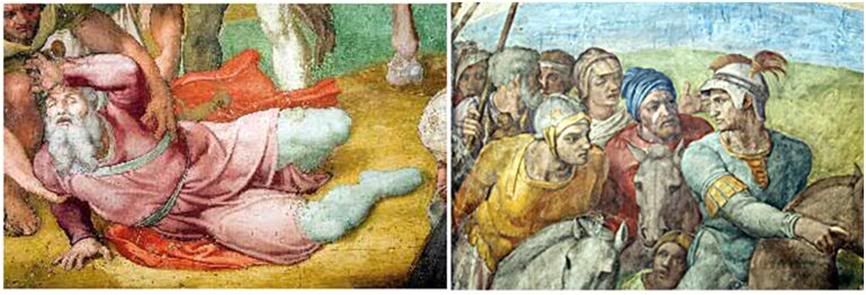 Details from Michelangelo's Conversion of St. Paul (left) and Crucifixion of St. Peter in the Pauline Chapel; full view of both frescoes below.
Details from Michelangelo's Conversion of St. Paul (left) and Crucifixion of St. Peter in the Pauline Chapel; full view of both frescoes below.
 CONDOLENCES FROM THE HOLY FATHER
CONDOLENCES FROM THE HOLY FATHER
Through Cardinal Tarcisio Bertone, Pope benedict XVI today extended his condolences and prauers to the families and surviving victims of two tragedies.
The first was to the Archbishop of Lucca in Tuscany for the deaths of at least 14 people adn dozens more injured when a freight train carrying liquefied petroleum gas derailed near the train station Sunday night in the twon of Viareggio, The LPG in at least two wagons exploded, and the resulting fires caused deaths and injuries to residents in the neighborhood. It was Italy's worst train accident in years.
The second telegram was to the Apostolic Nuncio in Kuwait, who is nearest to Yemen, where a Yemenia Airways flight carrying 153 persons on board from San'a, the Yemeni capital, to Moroni, capital of the island nation of Comoros (off the East African coast between Mozambique and Madagascar), crashed into the Indian Ocean before a scheduled midnight landing in gusty weather. A 14-year-old girl plucked alive from the sea was the lone survivor.
[Modificato da TERESA BENEDETTA 15/07/2009 22:43] |
| |
 01/07/2009 00:51 01/07/2009 00:51 |
|
| | | OFFLINE | | Post: 17.819
Post: 488 | Registrato il: 28/08/2005
Registrato il: 20/01/2009 | Administratore | Utente Senior | |
|

 New discoveries make St. Paul
New discoveries make St. Paul
very here and now:
Benedict XVI has given him
new life in more ways than one
The oldest depiction of the apostle has been found just a short distance from his tomb, which has also
yielded exciting new information.
The early Church wanted to represent Paul as the Christian Plato. A daring decision that is still relevant
in our day when a theologian Pope is in Peter's Chair, a modern Father of the Church.

ROME, June 30, 2009 - The year dedicated to St. Paul, two millennia after his birth, has concluded with two important discoveries announced on the same day, the vigil of Saints Peter and Paul.
The first discovery was revealed by Benedict XVI in person, in his homily for vespers on June 28, in the Roman Basilica of St. Paul's Outside the Walls:
"We are gathered at the tomb of the apostle, whose sarcophagus, kept under the papal altar, was recently made the object of a careful scientific analysis. A tiny perforation was made in the sarcophagus, which had not been opened for many centuries, for a special probe that picked up traces of a valuable linen cloth dyed purple, laminated with pure gold and a blue-colored cloth with linen thread. It also detected grains of red incense and of substances containing protein and calcium. Moreover, very tiny fragments of bone, subjected to Carbon-14 dating by experts who were unaware of their origin, were determined to belong to a person who lived between the first and second centuries. This seems to confirm the unanimous and unopposed tradition that these are the mortal remains of the apostle Paul."
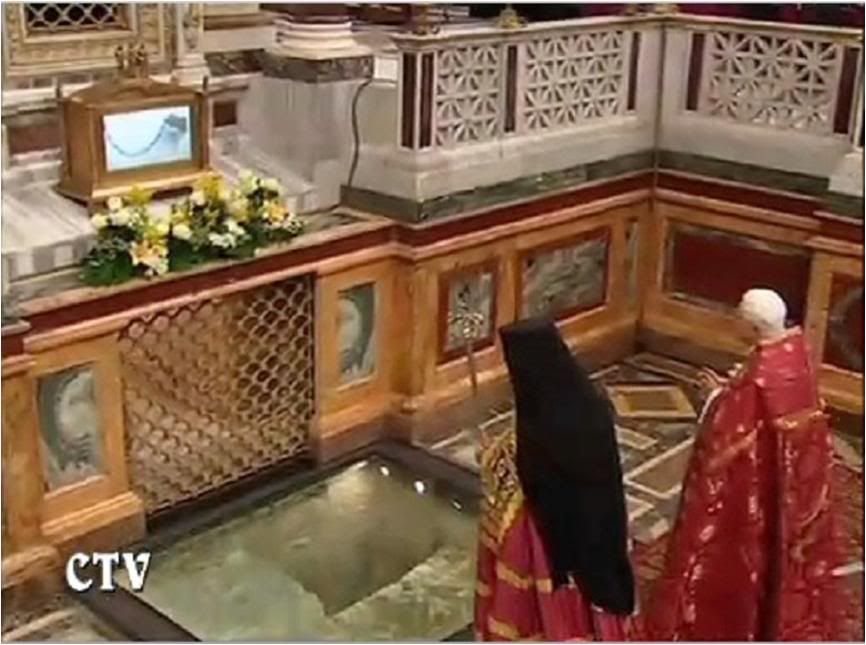 At the opening of the Pauline Year last year, Benedict XVI and Bartholomew I pay homage at the tomb of St. Paul with what was then a newly installed glass lid covering a small rectangle showing part of the tomb for the benefit of pilgrims. Below left, the main altar at St. Paul's built over the saint's tomb; and right, Cardinal Lanza di Montezemolo showing the parts of the tomb visible to pilgrims today. .
At the opening of the Pauline Year last year, Benedict XVI and Bartholomew I pay homage at the tomb of St. Paul with what was then a newly installed glass lid covering a small rectangle showing part of the tomb for the benefit of pilgrims. Below left, the main altar at St. Paul's built over the saint's tomb; and right, Cardinal Lanza di Montezemolo showing the parts of the tomb visible to pilgrims today. .
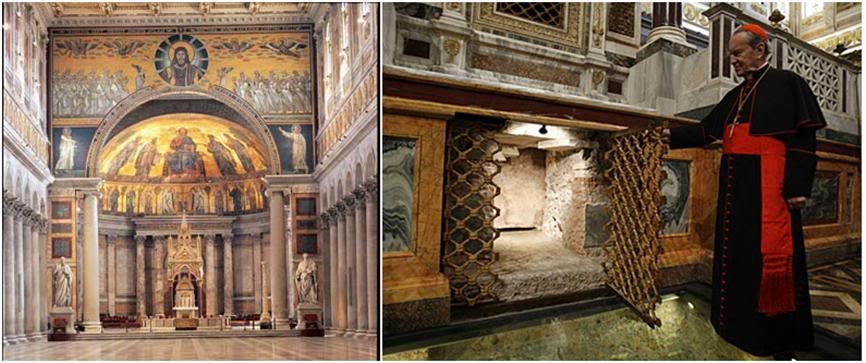
So for Paul, too - as also for the apostle Peter, whose tomb has already been identified with certainty beneath the main altar of the basilica of St. Peter at the Vatican - there is important confirmation that he is buried precisely where he has always been venerated: under the main altar of the Roman basilica dedicated to him.
The second discovery was announced earlier by L'Osservatore Romano in its June 28 edition.
It is that of the oldest known depiction of the apostle Paul, dating back to the fourth century.

This image of Paul emerged last June 19, from the excavations that are underway in a catacomb named after St. Thecla, along the Via Ostiense, leading from Rome to the sea, a short distance from the Basilica of the apostle.
Using laser beams to clean the vault of a niche, the archaeologists saw a rich fresco decoration re-emerge. At the center of the vault appeared the image of the Good Shepherd, surrounded, in four arches, by the figures of Paul - the best preserved of the four - of Peter, and probably of two other apostles.
The archaeologists Fabrizio Bisconti and Barbara Mazzei provided all of the details of the discovery in two extensive accounts in the newspaper of the Holy See. But one element is more striking than all the rest.
And it concerns the reasons that led to depicting the apostle Paul as we see him in this fresco, and then in so many others that followed: as a pensive philosopher, with penetrating expression, high forehead, incipient baldness, and pointed beard.
In an exhibition which opened last week dedicated to St. Paul, as depicted in art and books belonging to the Vatican Museums, two of the pieces on display are busts made in the Roman era of two philosophers - one of which is probably Plotinus - who bear a strong resemblance to the ancient depictions of Paul, beginning with the one that has just been discovered.
The same question [why the early Christian figures are depicted according to identifiable iconographic conventions] may be asked about the apostle Peter, who is traditionally depicted with short, thick white hair, his face broad and his expression decisive, his beard also short and full. And so on for other characters of sacred history.
[When I first saw the portrait of St. Paul on Page 1 of the OR last Saturday, with an icon of Peter and Paul on the same page, the thought that first came to my mind was that Paul the intellectual (he was schooled as a rabbi, somewhat like a doctor of the law - Mosaic law - at the feet of one of the great masters of his day) provided the intellectual scaffolding for the amazingly coherent structure of Christian doctrine erected on the rock that is Peter, the sturdy, down-to-earth, sometimes fallible fisherman from Galilee, whose simple faith and God's grace gave him all the wisdom he needed for his own mission. What a pair! The very paradigm of faith and reason... It becomes clear that the incident on the road to Damascus was all part of Christ's plan for his fledgling Church. Peter needed an alter ego to help spread the Word.]
Portraiture was very widespread in Greek and Roman art. But in Jewish culture, human images were forbidden, and therefore it was unthinkable that Paul and the others would have themselves depicted. It was only later that the Church accepted the depiction of figures of the Christian faith.
But how? Here is the evocative explanation given by Professor Antonio Paolucci, director of the Vatican Museums and a great art historian, in presenting the exhibition on St. Paul:
"The problem was posed between the third and fourth centuries, when a Church that had become widespread and well structured made the great and brilliant wager that is at the basis of our entire artistic history.
"It accepted and made its own the world of images, and accepted it in the forms in which the Greco-Roman stylistic and iconographic traditions had developed it. It was in this way is that Christ the Good Shepherd took on the appearance of Pheobus Apollo or Orpheus, and that Daniel in the lion's den had the appearance of Hercules, the victorious nude athlete.
"But how could one represent Peter and Paul, the princes of the apostles, the pillars of the Church, the foundations of the hierarchy and doctrine? Someone got a good idea. He gave the first apostles the appearance of the first philosophers.
"So Paul, bald, bearded, with the serious and focused air of the intellectual, had the appearance of Plato or perhaps of Plotinus, while that of Aristotle was given to the pragmatic and worldly Peter, who has the task of guiding the professing and militant Church through the snares of the world."
If this is what happened, then the Church in the early centuries had no reservations about attributing to the apostles, and to Paul in particular, the title of philosopher, nor of handing down, studying, and proclaiming in its entirety his thought, which is certainly not easy to understand and accept.
The same can be said of the Fathers of the Church. In Christianity's initial phase of expansion, when the transmission of the Christian faith to the Gentiles was in full development, the Church never considered watering down or taming its message in order to make it more acceptable to the men of the time.
The depiction of Paul the philosopher is an eloquent warning to those who today deny relevance to a Pope theologian like Benedict XVI, a modern Father of the Church.
There, Magister has gone and said what has been begging to be said! We have a living Doctor of the Church - as some among us have advanced enthusiastically for some time - who is also very much in the mold of those great Fathers of the Church from antiquity whom he has introduced to us so memorably in his catecheses, bishops and theologians who defended the faith in its purity and integrity in times of great peril and challenge.

[Modificato da TERESA BENEDETTA 02/07/2009 01:38] |
| |
 01/07/2009 12:53 01/07/2009 12:53 |
|
| | | OFFLINE | | Post: 17.820
Post: 489 | Registrato il: 28/08/2005
Registrato il: 20/01/2009 | Administratore | Utente Senior | |
|

 Pope greets new archbishops
Pope greets new archbishops
and their delegations:
"Always be a sign of unity
among the faithful'


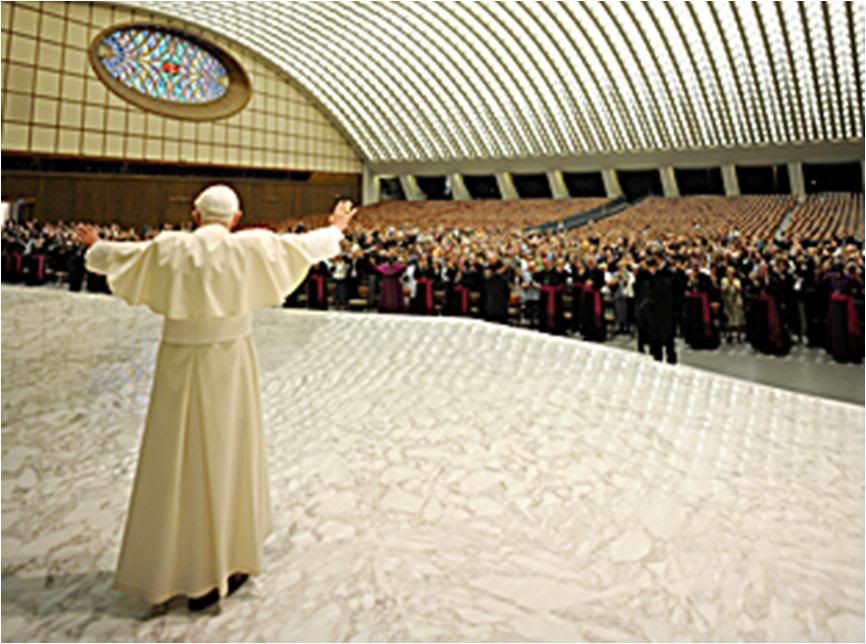


VATICAN CITY, 30 JUN 2009 (VIS) - This morning in the Vatican, the Pope received the 34 metropolitan archbishops upon whom he imposed the pallium yesterday, Solemnity of Sts. Peter and Paul, Apostles. The archbishops were accompanied by family members, friends and diocesan faithful who had come to Rome for the event.
The Holy Father addressed the prelates in various languages. To the new Italian archbishops he expressed the hope that, during the recently-inaugurated Year for Priests, they would "be exemplary pastors, zealous and rich in love for the Lord and for your communities. Thus you will guide and provide solid support for priests, your primary collaborators in pastoral ministry, and co-operate effectively in spreading the Kingdom of God throughout the beloved land of Italy".
Benedict XVI also had words of encouragement for new Spanish-speaking archbishops: "Following the footsteps of the Good Pastor", he said, "always be signs of unity among your faithful, strengthening bonds of communion with Peter's Successor, with your suffragan bishops and with everyone who collaborates in your evangelising mission. In this Year for Priests that has just begun, keep your clergy very close to your hearts. They expect to be kindly treated by you, like fathers and brothers who accept them, listen to them and show concern for them".
The Pope had special words for Archbishop Mieczyslaw Mokrzycki of Lviv of the Latins, Ukraine, for "the service he has given the Church, as a collaborator of mine and, prior to that, of my venerated predecessor John Paul II".
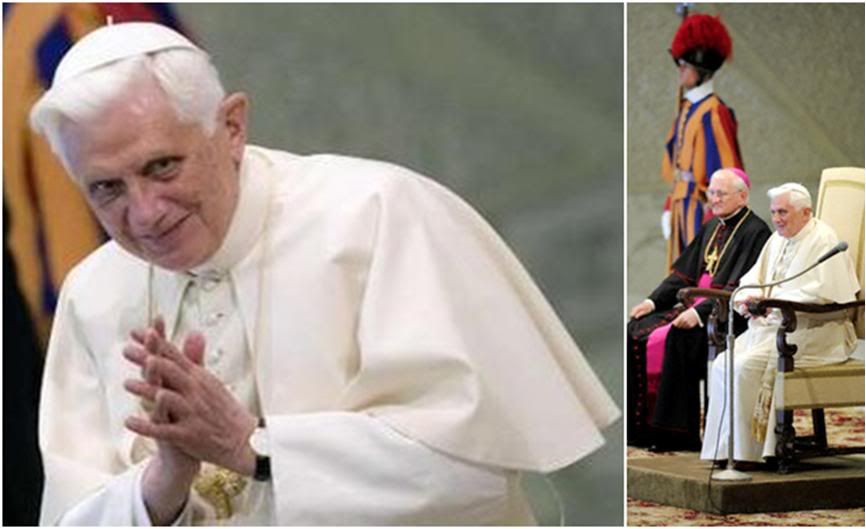
 Here is a translation of the Holy Father's plurilingual address. He began in Italian:
THE POPE'S ADDRESS
Here is a translation of the Holy Father's plurilingual address. He began in Italian:
THE POPE'S ADDRESS
TO THE NEW METROPOLITANS
Dear brothers in the Episcopate,
Dear brothers and sisters,
After the celebrations of the solemnity of the holy apostles Peter and Paul, it is for me a true pleasure to meet all of you in special audience, metropolitan Archbishops who received the pallium yesterday at St. Peter's Basilica, and to welcome your families and friends who have accompanied you here.
This prolongs the joy of the communion experienced during the feast of the two great Apostles, on which I imposed the pallium on you, symbol of the unity which links the pastors of the local Churches to the Successor of Peter, Bishop of Rome.
I address a heartfelt welcome to each of you who have come here from every continent, showing in a significant way the face of the Catholic Church spread around the world.
I greet you first, beloved Pastors of the Church in Italy. I greet Mons. Giuseppe Betori, Archbishop of Florence; Mons. Salvatore Pappalardo, Archbishop of Syracuse; and Mons. Domenico Umberto D’Ambrosio, Archbishop of Lecce.
We are at the beginning of the Year for Priests; may it therefore be your concern to be exemplary pastors, zealous and rich in love for the Lord and for your communities. You will thus be able to lead and firmly sustain the priests, your first collaborators in the pastoral ministry, so they may cooperate effectively in spreading the Kingdom of God in the beloved land of Italy.
He spoke next in French:
I am happy to welcome the French-speaking pilgrims who came to accompany the new metropolitan archbishops on whom I had the joy of conferring the pallium. I wish to greet Mons. Ghaleb Moussa Abdalla Bader, Archbishop of Algiers (Algeria); Mons. Pierre-André Fournier, Archbishop of Rimouski (Canada); Mons. Joseph Aké Yapo, Archbishop of Gagnoa (Ivory Coast); Mons. Marcel Utembi Tapa, Archbishop of Kisangani (Democratic Republic of the Congo); and Mons. Philippe Ouédraogo, Archbishop of Ouagadougou (Burkina Faso).
I also address warm greetings to the bishops, the priests and the faithful of your countries, assuring them of my fervent prayers.
The pallium is a sign of particular communion with the Successor of Peter. May it also be for the priests and faithful of your dioceses a call to consolidate ever more an authentic communion with their pastors and among all the members of the Church.
Next, he spoke in English:
I extend warm greetings to the English-speaking Metropolitan Archbishops upon whom I conferred the pallium yesterday: Archbishop Paul Mandale Khumalo of Pretoria (South Africa); Archbishop J. Michael Miller of Vancouver (Canada); Archbishop Allen Henry Vigneron of Detroit (USA); Archbishop Anicetus Bongsu Antonius Sinaga of Medan (Indonesia); Archbishop Philip Naameh of Tamale (Ghana); Archbishop Timothy Michael Dolan of New York (USA); Archbishop Vincent Gerard Nichols of Westminster (UK); Archbishop Robert James Carlson of Saint Louis (USA); Archbishop Francis Xavier Kriengsak Kovithavanij of Bangkok (Thailand); Archbishop George Joseph Lucas of Omaha (USA); Archbishop Gregory Michael Aymond of New Orleans (USA) and Archbishop Patebendige Don Albert Malcom Ranjith of Colombo (Sri Lanka).
I also welcome their family members, their relatives, friends and the faithful of their respective Archdioceses who have come to Rome to pray with them and to share their joy on this happy occasion.
The pallium is received from the hands of the Successor of Peter and worn by the Archbishops as a sign of communion in faith and love and in the governance of God’s People. It also recalls to Pastors their responsibilities as shepherds after the heart of Jesus.
To all of you I affectionately impart my Apostolic Blessing as a pledge of peace and joy in the Lord.
He said the following in Spanish:
I cordially salute the Spanish-speaking metropolitan Archbishops who came to Rome for the solemn ceremony of the imposition of the pallium:
Domingo Díaz Martínez, of Tulancingo (Mexico); Manuel Felipe Díaz Sánchez, of Calabozo (Venezuela); José Luis Escobar Alas, of San Salvador (El Salvador); Carlos Osoro Sierra, of Valencia (Spain); Víctor Sánchez Espinosa, of Puebla de los Ángeles (Mexico); Carlos Aguiar Retes, of Tlalnepantla (Mexico); Ismael Rueda Sierra, of Bucaramanga (Colombia), and Braulio Rodríguez Plaza, of Toledo (Spain; along with your families, friends, priests and faithful from your respective local Churches who are with you,
Dear brothers in the Episcopate, may the crosses of black silk embroidered on the pallium remind you that you must configure yourselves more and more every day to Jesus Christ.
Following his steps as the Good Shepherd, always be signs of unity among the faithful, strengthening your bonds of communion with the Successor of Peter, with your suffragan bishops, and with all those who work with you in your evangelizing mission.
In this Year for Priests, care for your priests deep within your hearts, as they expect from you a friendly treatment, like fathers and brothers who welcome them, listen to them and are concerned about them.
I commend yourselves and your diocesan communities under the protection of the Most Blessed Mary, Queen of Apostles, who is so much venerated in the countries you come from - Mexico, Venezuela, El Salvador, Colombia and Spain.
He continued in Portuguese:
I welcome with joy the families and friends of the new Metropolitan Archbishops of Brazil who came to accompany you for the reception of the pallium, a sign of profound communion with the Successor of Peter. I address particularly Dom Sérgio da Rocha, of Teresina; Dom Maurício Grotto, of Camargo de Botucatu; Dom Gil Antônio Moreira, of Juiz de Fora; and Dom Orani João Tempesta, of São Sebastião do Rio de Janeiro.
Please convey my greeting to the priests and all the faithful of your archdioceses, so that, united in the same faith as Peter, you may contribute to the evangelization of society. As a token of joy and peace in the Lord, I grant my blessing to all.
In Ukrainian, he said this:
I greet you, Mons. Mieczyslaw Mokrzycki, Archbishop of Lviv of the Latins, and those who are with you in this moment of strong ecclesial communion. Once more, I thank you for the service you have given to the Church as one of my co-workers, and before that, of my venerated predecessor John Paul II.
May the Spirit of the Lord be with you in your pastoral ministry in favor of the faithful entrusted to your care, to whom I send my warm greetings.
In Polish he said:
I cordially greet all the Poles who are present, in particular, the new Metropolitan of Szczecin-Kamień, Archbishop Andrzej Dzięga, who received the pallium yesterday, and the faithful from that city.
In the Year for Priests, may the pallium be, even for priests, a sumbol and a challenge to build communion with their own bishop, among themselves, and with the faithful.
Invoking for you all the gifts of divine love, I bless you from the heart. Praise be to Jesus Christ.
He ended the address in Italian:
Dear brothers and sisters, may the memory today of the Protomartyrs of Rome be a stimulus for each of you towards an ever more intense love for Jesus Christ and his Church.
May the maternal help of Mary, Mother of the Church, of the holy Apostles Peter and Paul, and of St. Jean Marie Vianney, go with all of you.
To each and everyone, my blessing.



[Modificato da TERESA BENEDETTA 15/07/2009 21:56] |
| |
 01/07/2009 13:32 01/07/2009 13:32 |
|
| | | OFFLINE | | Post: 17.821
Post: 490 | Registrato il: 28/08/2005
Registrato il: 20/01/2009 | Administratore | Utente Senior | |
|

July 1
 Blessed Junipero Serra (b. Mallorca 1713-d. California 1784)
Blessed Junipero Serra (b. Mallorca 1713-d. California 1784)
Franciscan theologian and missionary
OR for 6/30-7/1/09:

Benedict XVI announces the imminent publication of his third encyclical:
'Love in truth for a new world'
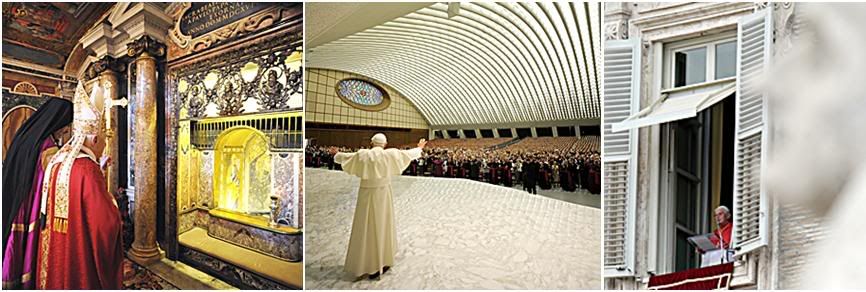 Today's double issue includes reportage on the Sunday Vespers that closed the Pauline Year, the Mass of Saints Peter and Paul, with the imposition of palliums on new metropolitans, and the Angelus message on Sunday; and his audience for the new metropolitans and their delegations yesterday. Also included is his message of condolence for the victims and families affected by the freight train accident in Viareggio, Italy. The new discoveries about St. Paul that have brought the Apostle very much here and now just as his jubilee year came to a close are the subject of an editorial commentary called appropriately 'Paul among us'. Finally, an editorial on 'Faith and the apostles'. Peter and Paul are illustrated by details from Michelangelo's frescoes The conversion of St. Paul and The Crucifixion of Peter in the newly restored Pauline Chapel of the Apostolic Palace.
Today's double issue includes reportage on the Sunday Vespers that closed the Pauline Year, the Mass of Saints Peter and Paul, with the imposition of palliums on new metropolitans, and the Angelus message on Sunday; and his audience for the new metropolitans and their delegations yesterday. Also included is his message of condolence for the victims and families affected by the freight train accident in Viareggio, Italy. The new discoveries about St. Paul that have brought the Apostle very much here and now just as his jubilee year came to a close are the subject of an editorial commentary called appropriately 'Paul among us'. Finally, an editorial on 'Faith and the apostles'. Peter and Paul are illustrated by details from Michelangelo's frescoes The conversion of St. Paul and The Crucifixion of Peter in the newly restored Pauline Chapel of the Apostolic Palace.
 THE POPE'S DAY
General Audience today
THE POPE'S DAY
General Audience today - The Holy Father once more spoke about the role of priests in society today,
stressing once more that their mission is to announce the Gospel adn administer the sacraments,
not social activism.
The Vatican announced that after the special audience for the new metropolitans yesterday (Monday),
the Holy Father met separately with Mons. Mieczyslaw (Mietek) Mokrzycki, Archbishop of Lviv
of the Latins (Ukraine).
POPE'S PRAYER INTENTIONS
FOR JULY 2009
General prayer intention:
"That Christians in the Middle East may live their faith in complete freedom and become instruments of reconciliation and peace."
Mission intention:
"Through the witness of the faithful, may the Church be the seed and soil of a humanity reconciled to be God's one true family on earth."
 And finally, a publication date
And finally, a publication date
for 'Caritas in veritate'

Vatican City, July 1 (dpa) - Pope Benedict XVI's latest encyclical, a document on how the global economy should take into account the needs of the poor, is to be published on July 7, the Vatican said Wednesday. Entitled Caritas in veritate, in English, Charity in Truth, the text - compiled with the input of several experts - was given final approval when Benedict signed it on Monday.
The encyclical's publication on the eve of the July 8-10 Group of Eight summit, in L'Aquila, Italy, is widely seen as a message by the pontiff to leaders of the world's most advanced nations.
The Vatican has said Benedict had been working on the encyclical since 2007, but held back on issuing it so that he could update it to reflect the global economic crisis.
Traditionally, encyclicals are the most authoritative documents a pope can issue. Benedict has written two in his four years as Pope: God is Love in 2006 and Saved by Hope in 2007.
[Modificato da TERESA BENEDETTA 02/07/2009 13:36] |
| |
 01/07/2009 15:29 01/07/2009 15:29 |
|
| | | OFFLINE | | Post: 17.823
Post: 492 | Registrato il: 28/08/2005
Registrato il: 20/01/2009 | Administratore | Utente Senior | |
|
 GENERAL AUDIENCE TODAY
GENERAL AUDIENCE TODAY
For the second week in a row, the Holy Father today spoke about the Year for Priests in his catechesis at the General Audience held in St. Peter's Square.
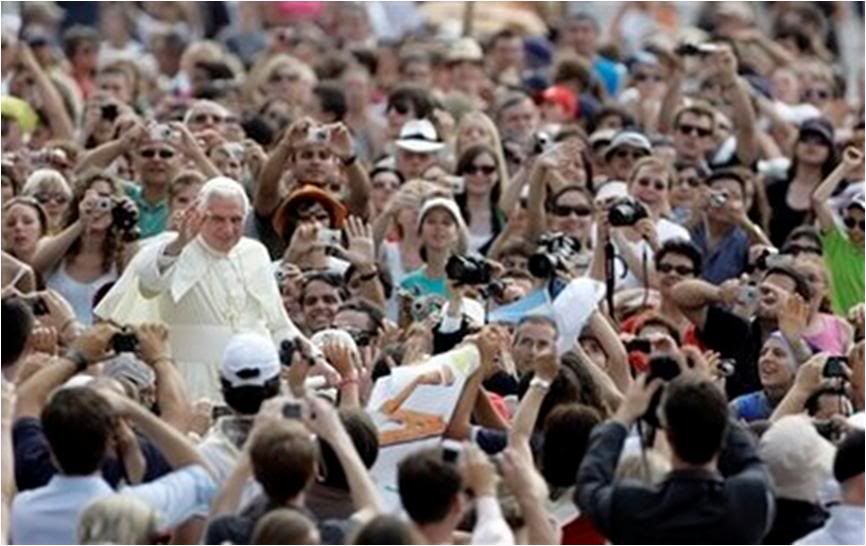

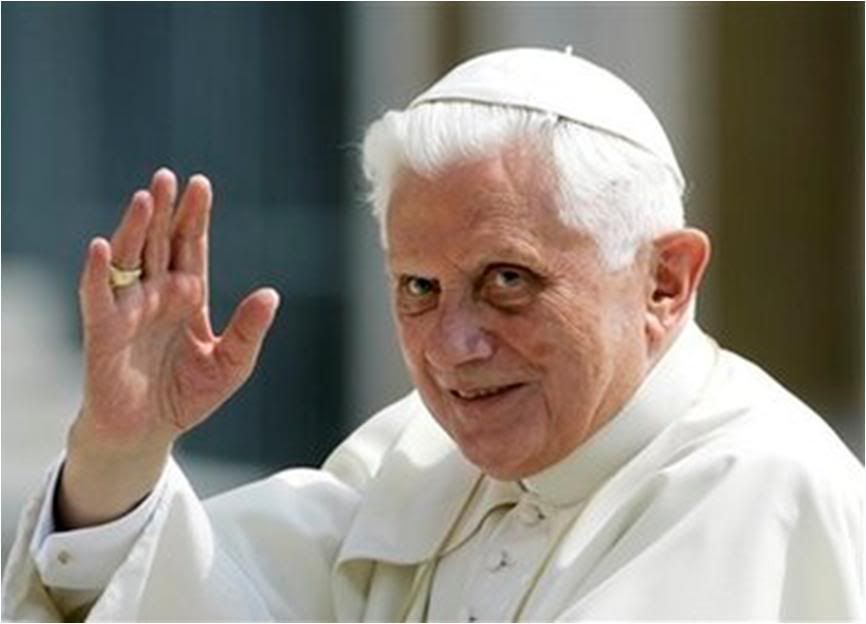

Here is how the Pope synthesized his catechesis in English:
There is a close link between the Pauline Year, which concluded last Sunday, and the Church’s current celebration of the Year for Priests. As we have seen, Saint Paul, in his life and his writings, teaches us that the mystery of Christ must stand at the very heart of our lives as individuals and as a community.
This is true in a very special way of priests. In Saint John Mary Vianney, the patron saint of parish priests, we see a wonderful example of a priest whose person was completely identified with his ministry.
The priest’s personal identity, grounded in his calling and his sacramental configuration to Christ, may not be separated from his pastoral activity.
Indeed, the ministry of every priest is essentially "cultic", in the fullest sense of the word: it is meant to enable the faithful to offer their lives to God as a pleasing sacrifice (cf. Rom 12:1).
It is my hope that this Year for Priests will help all priests to appreciate the immense grace of their vocation, consecration and mission. During this Year may the whole Church pray and work more fervently for the sanctification of priests, an increase of priestly vocations, and a greater appreciation of the role of the priest in the life of the ecclesial community.
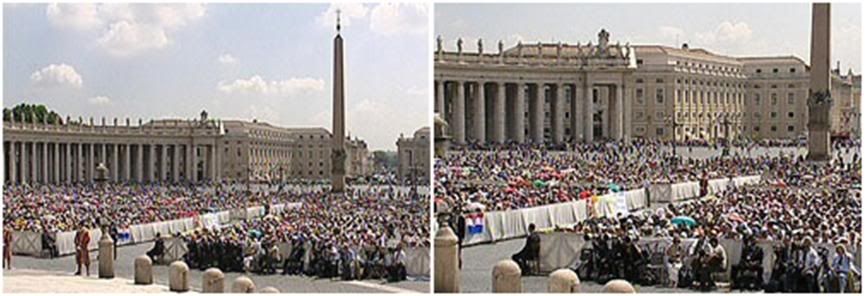


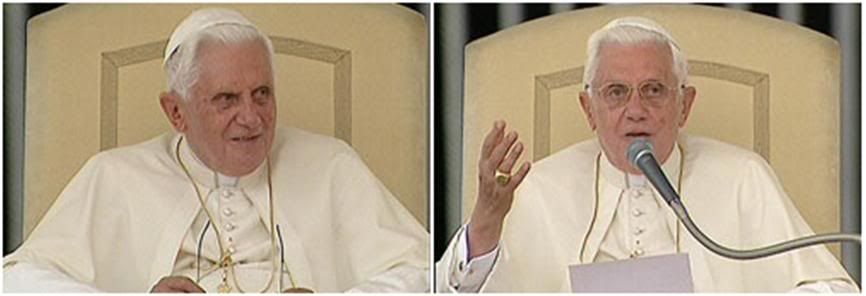 THE HOLY FATHER'S CATECHESIS
THE HOLY FATHER'S CATECHESIS
Dear brothers and sisters,
As you know, with the celebration of the First Vespers of the Solemnity of Saints Peter and Paul at the Basilica of St. Paul outside the Walls last Sunday, the Pauline Year commemorating the second bimillenary of the birth of the Apostle to the Gentiles came to an end.
Let us thank the Lord for the spiritual fruits which this important initiative has brought to so many Christian communities. As a precious legacy of the Pauline Year, we can accept the Apostle's invitation to deepen our knowledge of the mystery of Christ so that he may truly be the heart and center of our personal and communitarian existence.
Indeed, this is the indispensable condition for true spiritual and ecclesial renewal. As I had occasion to underscore at the first Eucharistic celebration in the Sistine Chapel after my election as Successor to the Apostle Peter, it is precisely from full communion with Christ that "that every other element of the life of the Church flows from, above all, communion among all the faithful, commitment to announcing and bearing witness to the Gospel, and the ardor of charity for all, especially towards the poor and the humble" (cfr Insegnamenti, I, 2005, pp. 8-13).
This applies first of all to priests. For this, let us thank the Providence of God who now offers us the opportunity to celebrate the Year for Priests. I wish with all my heart that it may constitute for every priest an opportunity for interior renewal and, consequently, of firm reinvigoration in the commitment to his own mission.
As we constantly referred to St. Paul in the Pauline Year, likewise in the following months, we shall be looking first of all towards St. Jean Marie Vianney, the holy Curate of Ars, on the 150th anniversary of his death.
In the letter that I wrote to all priests for this occasion, I emphasized the quality that shone best in the existence of this humble minister of the altar: "his total identification with his own ministry".
He loved to say that "a good pastor, a pastor after the Lord's heart, is the greatest treasure that the good God can grant to a parish, and one of the most precious gifts of divine mercy".
And then, almost as though he could not quite believe the greatness of this gift and the task entrusted to a poor human creature, he exclaimed: " O, how great a priest can be!... If he understood it all, he would die... God 'obeys him': he says a few words and Our Lord comes down from heaven to enclose himself in a tiny host!"
In fact, simply by considering the binomial "identity-mission', every priest should be better able to appreciate the necessity for that progressive identification with Christ that guarantees the faithfulness and fecundity of evangelical witness.
The very motto of the year for Priests - "Faithfulness to Christ, faithfulness of the priest' - shows that the gift of divine grace precedes every possible human response and pastoral reality, and thus, in the life of a priest, missionary proclamation and worship are never separable, just as his ontological-sacramental identity and evangelizing mission can never be separated.
Moreover, the goal of every priest's mission, we can say, is 'cult-ic' [about worship] - that all men may be able to offer the self to God as a living host that is holy and pleasing to him (cfr Rm 12,1), which in creation itself, in men, becomes worship, praise of the Creator, from which men receive that charity which they are called on to dispense abundantly with each other.
This was clearly understood in early Christianity. St. John Chrysostom said, for instance, that the sacrament of the alter and the 'sacrament of the brother' or 'sacrament of the poor' constitute two aspects of the same mystery.
Love for neighbor, the concern for justice, and attention towards the poor, are not so much themes of social morality, as they are the expression of a sacramental concept of Christian morality, since, through the ministry of priests, the spiritual sacrifice of all the faithful is completed in union with that of Christ, the only Mediator.
It is a sacrifice that priests offer in a bloodless sacramental way in anticipation of the second coming of the Lord. This is the principal dimension, essentially missionary and dynamic, of the priest's identity and ministry.
Through proclaiming the Gospel, he can generate faith in those who do not yet believe, so that they may join their sacrifice - translated into love of God and love for one's neighbor - to the sacrifice of Christ.
Dear brothers and sisters, in the face of so many uncertainties and a sense of exhaustion in the exercise of the priestly ministry, it is urgent to recover a clear and unequivocal conclusion about the absolute primacy of divine grace, recalling what St. Thomas Aquinas wrote: "The smallest gift of grace surpasses the natural goodness in the whole universe" (Summa Theologiae, I-II, q. 113, a. 9, ad 2).
The mission of every single priest depends above all, therefore, on his awareness of the sacramental reality of his 'new being'. The ever renewed enthusiasm of the priest for his mission depends on the certainty about his own identity, not artificially constructed, but freely and divinely given and received.
Even for priests, what I wrote in the encyclical Deus caritas est applies: "Being Christian is not the result of an ethical choice or a lofty idea, but the encounter with an event, a person, which gives life a new horizon and a decisive direction" (No. 1).
Having received an extraordinary gift of grace with their 'consecration', priests become permanent witnesses to their encounter with Christ. And on the basis of this interior awareness, they can fully carry our their 'mission' through announcing the Word and administering the Sacraments.
After the Second Vatican Council, the impression was given here and there that the mission of priests in our time was rather something more urgent: some think that in the first place, they should help construct a different society.
But the Gospel passage that we heard at the start [of the Audience] reminds us of the two essential elements of the priestly ministry. In those days as today, Jesus sent out the Apostles to announce the Gospel and gave them the power to drive out evil spirits.
'Announcement' and 'power' - namely, 'the Word" and 'Sacrament' - are thus the two fundamental pillars of priestly service, beyond their multiple possible configurations.
When one loses sight of this 'diptych' of consecration and mission, then it becomes truly difficult to understand the identity of the priest and his ministry in the Church.
What is a priest, in fact, but a man who has been converted and renewed in the Spirit, who lives out of a personal relationship with Christ, and constantly makes evangelical criteria his own?
What is a priest if not a man of unity and truth, conscious of his own limitations, and at the same time, of the extraordinary greatness of the vocation he has received, namely, that of extending the Kingdom of God to the very ends of the earth?
Yes, a priest is a man totally belonging to the Lord, because God himself called him and constituted him in his apostolic service.
And because be belongs totally to God, he belongs to all men, for all men.
During this Year for Priests which will extend up to the Solemnity of the Sacred Heart of Jesus next year, let us pray for all priests. May such prayer initiatives, and in particular, Eucharistic adoration, for the sanctification of priests and priestly vocations, multiply in the dioceses, parishes, religious communities especially the monastic,church associations and movements, and in various pastoral associations around the world - as a response to Jesus's call "to ask the master of the harvest to send out laborers for his harvest" (Mt 9,38).
Prayer is the first commitment, the true way of sanctification for priests, and the soul of authentic 'pastoral vocation'. The numerical scarcity of priestly ordinations in some countries not only should not discourage but should urge priests towards multiplying the spaces for silence and for listening to the Word, to provide better spiritual guidance and the sacrament of confession, in order that the voice of God, who continuously calls and confirms, may be heard and be promptly followed by young men.
He who prays has no fear; he who prays is never alone; he who prays saves himself. And the model for existence-become-prayer is without a doubt St. Jean Marie Vianney.
May Mary, Mother of the Church, help all priests to follow his example - to be, like him, witnesses for Christ and apostles of the Gospel.

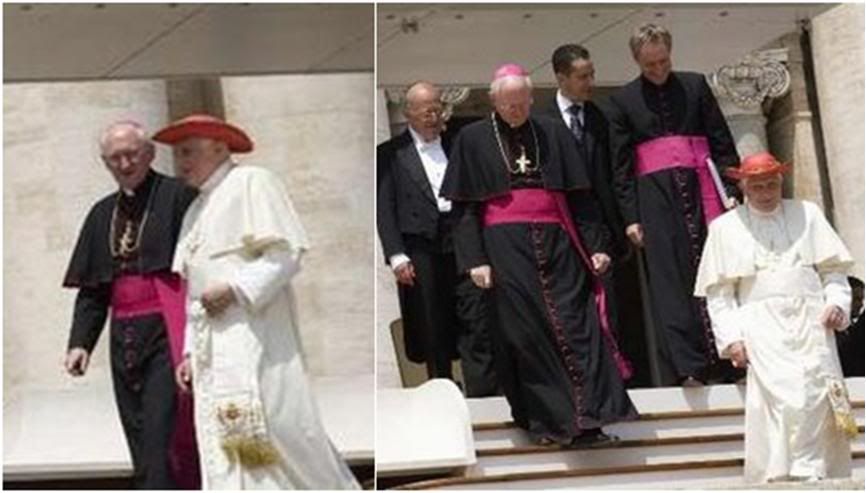

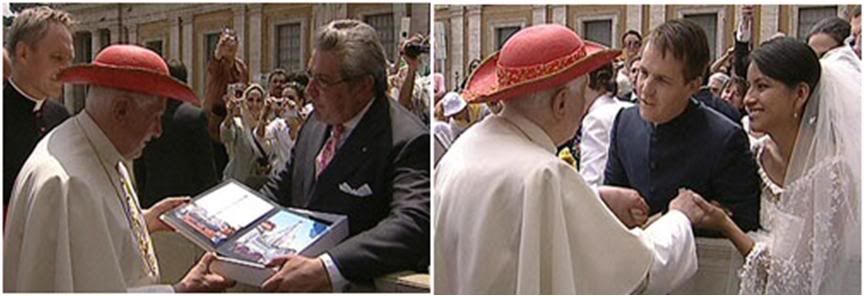
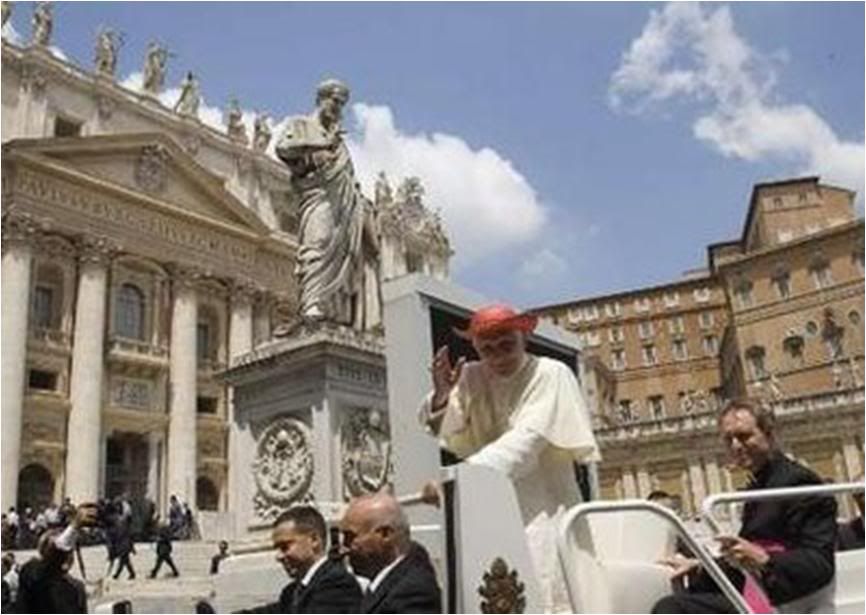
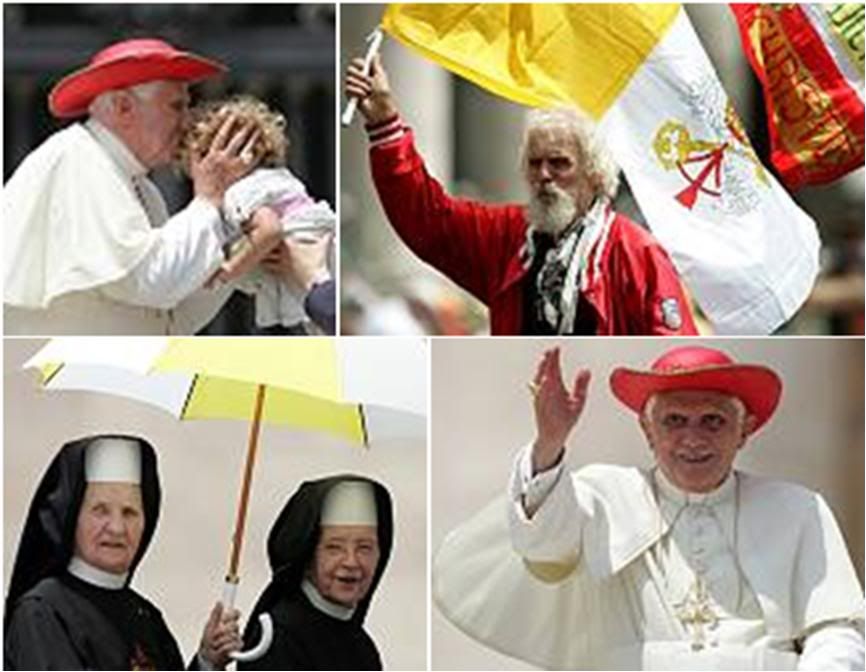

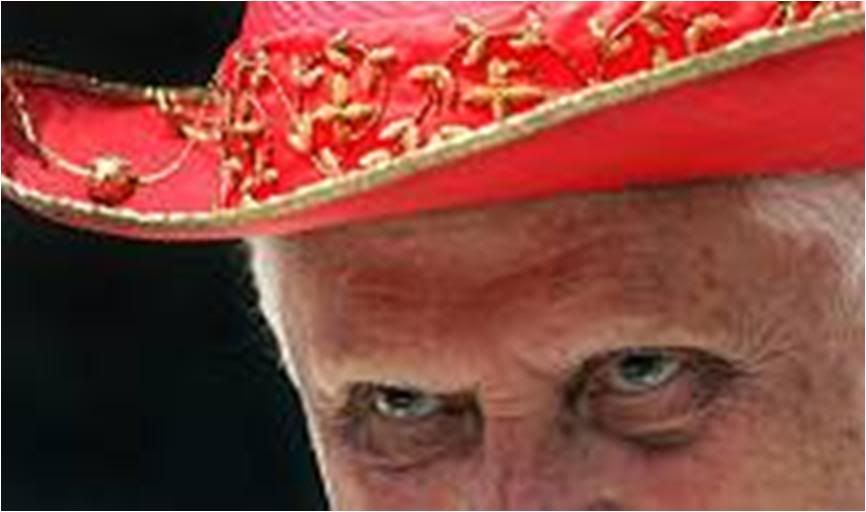
[Modificato da TERESA BENEDETTA 01/07/2009 21:54] |
| |
 01/07/2009 20:06 01/07/2009 20:06 |
|
| | | OFFLINE | | Post: 17.825
Post: 494 | Registrato il: 28/08/2005
Registrato il: 20/01/2009 | Administratore | Utente Senior | |
|
 I think I may have found a new reliable 'Ratzingerian' commentator in the Italian media - whose short pieces I have carried a couple of times before, from what appears to be a regular column he writes for the weekly Italian newsmagazine TEMPI under the rubric 'Recensire Ratzinger' ['Reviewing Ratzinger'). His brevity is as commendable as his observations and conclusions, which I can only describe as 'Benaddictian' as well as 'Benaddictive'. Here is this week's reflection:
The most intellectual of Popes
I think I may have found a new reliable 'Ratzingerian' commentator in the Italian media - whose short pieces I have carried a couple of times before, from what appears to be a regular column he writes for the weekly Italian newsmagazine TEMPI under the rubric 'Recensire Ratzinger' ['Reviewing Ratzinger'). His brevity is as commendable as his observations and conclusions, which I can only describe as 'Benaddictian' as well as 'Benaddictive'. Here is this week's reflection:
The most intellectual of Popes
is also the simplest of the faithful
Translated from

July 1, 2009
If one is much too taken by the stereotype of the professor-theologian dedicated to the battle against relativism and the conciliation of faith and reason, one might easily yield to the idea that Joseph Ratzinger is, above all else, a great theoretician, an intellectual well-equipped by training and experience to lock horns with secularism.
As much as all that does correspond to who he is, to see him only from this viewpoint is to risk missing an essential piece of Benedict XVI. One simply has to look at recent events.
For instance, the Year for Priests which he decreed in part as a homage to St. Jean Marie Vianney, whose relic he appropriately venerated before the ceremony that formally inaugurated the Year for Priests.
Also, the Pauline Year which ended Monday which has revived in the Church a devotion and a new attention to the Apostle of the Gentiles.
Then there was the Pope kneeling in front of the mortal remains of Saint Pio of Pietrelcina and then blessing the saint's heart [recovered after the exhumation of the body last year].
And so, one sees that Benedict, among so many other things, is also bringing the saints to the forefront of his Magisterium.
And that this most intellectual of the Popes, the refined and erudite theologian, does not disdain the gestures of devotion that the simplest of us perform.
In the face of the tendency today towards a 'disembodied' faith promoted by psycho-theology as well as evanescent sentimental spirituality, the Pope has a solution: to point to actual men and women who brought God to the world concretely with their own lives.
We, the faithful, who remain substantially flesh and bone, welcome such examples of faith which is visible and tangible.
[Modificato da TERESA BENEDETTA 01/07/2009 20:08] |
| |
 02/07/2009 00:17 02/07/2009 00:17 |
|
| | | OFFLINE | | Post: 17.827
Post: 496 | Registrato il: 28/08/2005
Registrato il: 20/01/2009 | Administratore | Utente Senior | |
|
 Faith and the apostles
Faith and the apostles
Editorial
by Giovanni Maria Vian
Translated from
the 6/30-7/1 issue of

For the feast of the holy patrons of Rome, Benedict XVI addressed all Catholics with words that deserve to be heard even beyond the visible confines of the Church and which will live on as a reflection on what is essential: the truth.
That truth which Peter and Paul preached until they had to shed their own blood under Nero, rendering to Christ the ultimate testimony ( martyrion, in Greek) in the capital of the Roman empire.
The martyrdom of the two Apostles founded the Church of Rome, as millions upon millions of faithful have acknowledged over the centuries, kneeling before their tombs identified at least 18 centuries ago by pious Christians in a tradition visibly supported by history.
As stated by Pius XII and Paul VI in the case of St. Peter, and now, as their present successor does for St. Paul.
Speaking of the ex-persecutor of Christians who was converted on the road to Damascus, the Pope recalled that with Christ came a new way of adoring God, a personal and profoundly true worship because it is affirmed with one's life. With that interior self-renewal which is the only way to change the world without conforming to it. A change into a new way of thinking and of being, not as children but as adults.
And certainly not in the sense, rather juvenile in fact, with which the term 'adult faith' has come to be turned on its head, by those who consider themselves mature and courageous to the point of opposing the Magisterium of the Church itself.
With dry irony, Benedict XVI points out that it does not take much courage to do that in a society that is de-Christianized! Rather, faith is truly adult and mature when it is able to commit itself - and the Pope cites examples - to the inviolability of human life from the moment of conception, and to the natural and Christian order of an indissoluble marriage.
Faith is adult and mature when, in the name of truth - which cannot be separated from love - it opposes lies and falsehood. The commitment to truth that refers itself back to Christ is profound: "We need reason illuminated by the heart so we can learn to act according to truth in love", as Benedict summed it up.
Even during his studies and in his youthful writings, Joseph Ratzinger, steeped in the Christian tradition, took on himself the task of explaining 'the alphabet of the faith' for our time, and he continues to carry out this service - which is both theological and pastoral - as the Successor of Peter.
Trough the first of the Apostles, he spoke of Christ as the 'bishop of souls' at the solemn liturgy of the imposition of the pallium on Monday to new metropolitan archbishops - this in itself a visible expression of Catholic communion.
Benedict XVI went deep into the truth that the apostles bore witness to and repeated that, notwithstanding conformism in the world and notwithstanding the enemies of the Church, for whom he used the evangelical term 'wolves', it is the mission of bishops and priests above all to open the hearts and souls of their flock to God - following the example of Peter and Paul, and of saints like Francis of Assisi, the Curate of Ars and Padre Pio.
Only this way, he stressed, is it possible to make God present in the world and thus to change it.
|
| |
 02/07/2009 06:12 02/07/2009 06:12 |
|
| | | OFFLINE | | Post: 17.829
Post: 498 | Registrato il: 28/08/2005
Registrato il: 20/01/2009 | Administratore | Utente Senior | |
|

 An economic consultant talks
An economic consultant talks
about the 'social encyclical'
by GIACOMO GALEAZZI
Translated from

July 1, 2009
"The Pope had to update the encyclical to reflect the world crisis".
Two of the persons who had most contributed to the material for the Pope's third encyclical Caritas in veritatesaid that was the primary reason for the delays, corrections and adjustments made to the text.
"The draft was almost in final form nine months ago," said the economist Stefano Zamagni, professor of political economy and consultant to the Pontifical Council for Justice and Peace, "and just when it was ready to go to press, came the bank failures in the United States. Om September 15, 2008, when Lehman Brothers collapsed, the Pope decided that it was not possible to have a document that did not take these developments into account. In juridical terms, the Pontiff wanted a 'supplemental investigation' that would adequately reflect the global financial meltdown."
"It could not have been otherwise," Zamagni adds, "because the premise for the encyclical was globalization, which is tightly linked to the crisis we now have".
As for other economic influences on the text, Zamagni clarified the 'inspiration' attributed to Giulio Tremonti by the media.
[Tremonti is the current Italian minister for economy and finance, a staunch political and economic federalist who is an opponent of globalization and an advocate of tax cuts to stimulate the economy. He has written several books on taxation and international commerce.]
"The Tremontian term 'mercatismo' [which Tremonti uses to refer to the 'free market ideology'] does not appear in the encyclical," Zamagni says, "insofar as it is synonymous to an anarchic free market".
He said the various experts consulted had differing opinions on the optimal post-crisis position. "Some wanted the encyclical to hew closely to the crisis, but I argued against it, since three years from now, after the storm has passed, it will be water under the bridge. So it would not pay for an encyclical that will be read for decades to be so tightly bound to one episode."
Thus, he said, in the encyclical, "the crisis is cited as a remarkable example of greed raised to a moral system, but there is no specific chapter on the crisis - rather, it turns up as a recurring example for certain points." In all, he says, the pages referring to the crisis are no more than 2% of the total.
"In some passages, the crisis provides the background and paradigm for the argumentation, as when it points out that if the market economy loses its orientation for the common good. then it degenerates and leads to unemployment and neo-colonial conditions. In these and similar scenarios, the crisis proves and reinforces the basic assumptions of the encyclical."
Zamagni adds that "there is an ample paragraph devoted to the structural problem of environmental damage".
He acknowledges that most people are interested in whatever 'concrete proposals' the encyclical makes. He says that for the first time, the idea of 'non-profit' turns up in a social encyclical, and that there is open praise for the February 19 unanimous adoption by the European Parliament of a pluralistic concept of the social economy as one that can take many forms, not merely capitalist".
The encyclical, he says, is more favorable to the Italian notion of a 'civilian economy' against the Anglo-Saxon concept of a political economy - since the former "adds the principle of reciprocity to the economic discourse, alongside the classic principles of exchange and redistribution."
Thus, he said, "donations that have economic value should factor into businesses, families and organizations" and "instead of being reduced to a commodity, the person as worker must be central, and if he does not do what he is supposed to do, he must be corrected as one disciplines a child so that he may learn and grow from his error."
Also speaking about the encyclical was Cardinal Renato Raffaele Martino, president of the Pontifical Council for Justice and Peace, which is the Vatican agency sectorally responsible for contributing to the draft.
"There were a number of changes made starting last March in order to take the current crisis into account," he said. He met with the Pope on May 19 to discuss the changes.
Further adjustments were made to the propositive parts, he said, "but more than practical solutions, the text focuses on underscoring the fundamental principles of the Church's social doctrine."
"In other words," says the cardinal, "there are concrete references to economic realities, but it urges solutions that would promote global peace, human rights, subsidiarity, globalized humanism of labor, and commitment to charity."
 I am counting on the Holy Father to provide us with an encyclical that will be as pleasurably readable as the first two ones! Social doctrine and economic abstractions are usually soporific and rather mind-numbing to slog through, in any form, like the 'preview' given above which, of course, reflects nothing of the Pope's expository style and language....
I am counting on the Holy Father to provide us with an encyclical that will be as pleasurably readable as the first two ones! Social doctrine and economic abstractions are usually soporific and rather mind-numbing to slog through, in any form, like the 'preview' given above which, of course, reflects nothing of the Pope's expository style and language....
[Modificato da TERESA BENEDETTA 02/07/2009 15:47] |
| |
 02/07/2009 08:32 02/07/2009 08:32 |
|
| | | OFFLINE | | Post: 17.830
Post: 499 | Registrato il: 28/08/2005
Registrato il: 20/01/2009 | Administratore | Utente Senior | |
|


 Vatican publishes 'artistic edition'
Vatican publishes 'artistic edition'
of the Pope's catecheses on St. Paul
by Cardinal Giovanni Lajolo
Governor of Vatican City-State
Translated from
the 6/29-7/1/09 issue of
 Editor's Note: In the continuing program Imago Veritatis (Image of Truth), the Vatican publishing house presented last Tuesday, June 30, the book entitled The Apostle Paul(in the 'artistic' edition, that is, illustrated by appropriate works of art). Here is an excerpt from the presentation given by Cardinal Lajolo of Vatican City-State.
Editor's Note: In the continuing program Imago Veritatis (Image of Truth), the Vatican publishing house presented last Tuesday, June 30, the book entitled The Apostle Paul(in the 'artistic' edition, that is, illustrated by appropriate works of art). Here is an excerpt from the presentation given by Cardinal Lajolo of Vatican City-State.
At the end of the Pauline Year, the Vatican publishing house has given us a great gift to treasure for years to come.
It is the collection of the catecheses to the General Audiences on Wednesdays that the Holy Father, Benedict XVI, dedicated to St. Paul during the Jubilee year - 20 lessons given from July 2, 2008, to February 4, 2009.
It is not a random collection but an organic whole, corresponding to a carefully conceived lesson plan. The figure of St. Paul is first placed in its historic, religious, and cultural context, followed by the salient points of his impetuous and adventurous life story, then the great theological themes running through his thought, to conclude with a rapid historical review of how Paul has been received, interpreted, disputed and re-lived.
Between the first eight chapters and the other nine, there are three chapters dedicated to Paul's Christology. No other subject in the series receives as much attention.
One might therefore deduce that, according to Benedict XVI, this is the center of Paul's thought.
His treatment of the Pauline Christology is articulated according to three specific perspectives: the pre-existence and incarnation of Christ; the theology of the Cross; and the conclusiveness of the Resurrection.
"For St. Paul," says Benedict XVI, "the secret identity of Jesus is revealed in the mystery of the Resurrection, far more than in the Incarnation".
After Paul's Christology, what ranks next in importance according to the Pope's exposition is the doctrine of justification, to which he devotes two chapters, presented in mirror fashion: from works to faith, and from faith to works. Justification answers the question: "How does man become just in the eyes of God?"
Here, Benedict XVI is concerned with clarifying the question of justification through faith. In the answer to this question is found the dispute that originated the separation of Protestantism from the Catholic Church.
Luther, in his interpretation of Paul's Letter to the Romans, came to the conclusion that man is justified only through faith without need of works - sola fide.
The Council of Trent, in its session of January 1547, condemned the Lutheran interpretation.
How then does Benedict XVI deal with it? In the first of the two chapters dedicated to justification, "From works to faith", the Pope offers an explanation of the Pauline question, situating it in the cultural context experienced - and suffered - by Paul.
Mosaic law constituted a sort of wall against the cultural pressure of the pagan world which menaced the identity of the Jews and their very faith in one God.
This situation as radically transformed with the resurrection of Christ, by which the God of Israel became the God of all peoples. The 'wall' of Mosaic law - with its prescriptions, prohibitions and decrees - collapsed because it was now superfluous, since Christ, according to Benedict XVI, "guarantees our identity in the diversity of cultures".
The Pope refers explicitly to the memorable phrase in the Letter to the Ephesians: "In Christ Jesus... he who made both one and broke down the dividing wall of enmity, through his flesh, abolishing the law with its commandments and legal claims, that he might create in himself one new person in place of the two, thus establishing peace" (2, 13-15).
On the nature of justification and its coupling to faith, to sola fide, the Pope says, "To be just simple means being in Christ, with Christ, and this suffices.... Luther's expression 'sola fide' is true if faith is not placed in opposition to charity, to love. Faith is to look to Christ, to entrust oneself to Christ, to be attached to Christ, to conform oneself to Christ in one's life".
He adds: "This is essential: Christian ethic is not born from a system of commandments but it is a consequence of our friendship with Christ".
Between the subject of Christology and that of justification, there comes a subject that is not easy but it is indispensable: "Eschatology - awaiting parousia'.
Eschatology is the discussion of the 'last things', while parousia means the 'appearing', in this case, the second coming of Christ. Here is the famous passage from the first letter to the Thessalonians (also Paul's first Letter): "The dead in Christ will rise first. Then we who are alive, who are left, will be caught up together with them in the clouds to meet the Lord in the air. Thus we shall always be with the Lord" (4,16-17).
And here is Benedict XVI's very direct explanation: "Paul describes Christ's parousia in very vivid tones and with symbolic images that convey nonetheless a simple and profound message: in the end, we will be with the Lord. This, beyond the images, is the essential message: our future is 'to be with the Lord'; as believers, in life we are already with the Lord - our future, eternal life, has begun".
Another point which could not be absent in a presentation about Paul was his relationship with Peter. Benedict dedicates a chapter to the Council of Jerusalem and the 'incident at Antioch', a reference to Paul's mettlesome reproach to Peter.
In the time of Paul, Antioch was the Roman capital of Syria. There, the influz of pagans into the nascent Church was not limited to single persons but it became a consistent social manifestation such that "at Antioch, for the first time, the disciples were called Christians" (Acts 11,26).
What happened at Antioch was narrated by Paul himself in the Letter of the Galatians: Peter, arriving in Antioch, shared meals with the pagans, that is, without observing the Mosaic law on food; but when other Christians arrived who were observant Jews, in order not to scandalize them, he avoided sitting down to meals with the pagans, even leading some Christians to have the same attitude. Paul describes vividly how he opposed Peter to his face 'in the presence of everyone', reproaching Peter for his inconsistency.
This episode is often cited by those who say that Paul was more genuinely faithful to the Gospel, yet exercising Christian freedom, than was Peter.
Benedict XVI, in considering the topic of Christian freedom, which was an object of contention at the Council of Jerusalem as it was in Antioch, brings up the differing concerns of Peter and Paul on the basis of their different perspectives, notes: "Strangely, when writing to the Christians of Rome some years later (around the middle of the 50s decade A.D.), Paul found himself in an analogous situation and he would ask the 'strong' not to eat impure food in order not to lose or scandalize the 'weak': "It is good not to eat meat or drink wine or do anything that causes your brother to stumble" (Rom 14, 21).
And so Paul's impetuous consistency also had occasion to mature. Benedict XVI draws from this a lesson on spiritual freedom "which finds its orientation in faith in Christ and is made concrete by service to our brothers".
Significantly, the Pope dedicated a whole chapter to teh two letters to the Colossians and to the Ephesians, which have much in common in their language, in the concept of Christ as the head of the Church and the vertex of the cosmos, in presenting a domestic code - that is, the norms of virtuous behavior by members of the family - and in other aspects.
Allow me to cite some lines which reflect something, I think, of the Pope's musical soul: "While in Colossians, we read literally the invitation to 'exhort with psalms, hymns and spiritual songs, singing in Gratitude to God with your hearts' (3,16) in Ephesians, he recommends likewise "to speak among yourselves with psalms, hymns and spiritual songs, singing and praising the Lord with your hearts" (5,19).
We can meditate on these words: the heart should sing, says Benedict XVI, and thus also the voice, with psalms and hymns to enter into the tradition of prayer of all the Church in both the Old and New Testaments".
Benedict XVI is attached to an exegesis of Scriptural texts that is always historically founded. It is a scientific exegesis that is also immersed in the great living Tradition of the same doctrine as it has come down to us from the apostles themselves, and without loss of continuity, by the Fathers of the Church .
Such an exegesis is useful, indeed necessary, "to introduce us to an understanding of Scripture and catching in it the voice of Christ".
 has a few more interesting quotations from Cardinal Lajolo's presentation that are not in the above excerpt. Here is a translation:
The authoritativeness of Cardinal Ratzinger
has a few more interesting quotations from Cardinal Lajolo's presentation that are not in the above excerpt. Here is a translation:
The authoritativeness of Cardinal Ratzinger
About the doctrine of justification, Cardinal Lajolo recalled the 'historical agreement' signed on October 31, 1999, between the World Lutheran Federation and the Catholic Church: "It was thanks to the personal intervention of the then prefect of he Congregation for the Doctrine of the Faith, Cardinal Joseph Ratzinger, and his authoritativeness he enjoyed with John Paul II that it became possible to overcome the last doctrinal obstacles to the agreement in order to find the final formulation that allowed bilateral agreement".
'The Christ of faith is the Jesus of history'
Cardinal Lajolo also noted: "In a notion advanced by rationalism in teh past two centuries, scholars have opposed the Christ of the faith with what the claim to be the Jesus of history - a comparison that has been revived by the most recent exegetical theories".
Benedict XVI, he said, had dealt with that comparison masterfully at the beginning of JESUS OF NAZARETH, even in pastoral terms.
"The Christ of Paul's faith is the Jesus of history. And as it was for Paul, so it is for Benedict XVI and for us," Cardinal Lajolo concluded.
SIR also quotes from the other persons who were at the presentation of the book:
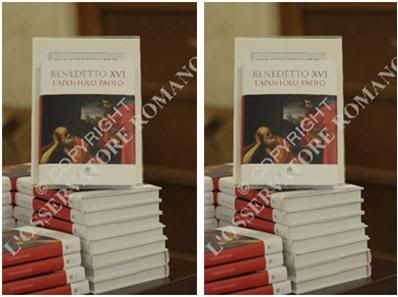
"During the Pauline Year, we published seven titles dedicated to St. Paul, with a total of about 50,000, half of them sold in less then two months," according to Don Giuseppe Costa, director of LEV, the Vatican publishing house.
The Pope's catecheses on St. Paul, he added, "have been translated and reprinted by at least 20 international publishing houses". The last request for rights was from the Japanese bishops' conference.
"We will continue to market the book enthusiastically because we are convinced it is a great help for pastoral ministry and for preaching."
Sandro Chierici, who edited the artistic edition of L'APOSTOLO PAOLO, chose the works of art to accompany the texts and 'give a face to Paul' whom he called 'our contemporary, because his experience was not different from that which every Christian today must live".
"Art is a privileged instrument capable of speaking to men in every age," he said, underscoring the catechetical significance of Christian art through the ages.
Antonio Paolucci, director of the Vatican Museums, spoke about the evolution of the images of St. Paul in art through the centuries, starting from the 'Hellenistic-Roman ecumene' which counteracted "the ferociously an-iconic culture of Judaism".
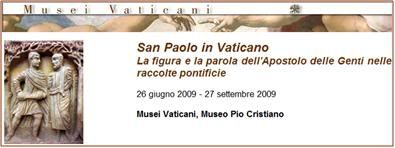
An exhibit on 'St. Paul in the Vatican: The figure and words of the Apostle of the Gentiles in the pontifical collections' opened on June 26 at the Museo Pio Cristiano of the Vatican Museums, and will run till September 25.
Paolucci dwelt on the iconography of St. Paul, depicted as the philosopher and intellectual that he was, in both the Latin West and the orthodox East, in the Greek world and the Slavic world.
He illustrated the fundamental models according to which "the apostle has been handed down in Christian imagery and therefore in the figurative arts - as a pillar of the Church along with Peter, doctor of theological wisdom, and therefore of Christian orthodoxy."
He also referred to the recently restored Pauline Chapel (dedicated to St. Paul but named after Pope Paul III who had it built) which will be inaugurated at Friday Vespers by the Holy Father.
[Modificato da TERESA BENEDETTA 03/07/2009 00:04] |
| |
 02/07/2009 13:31 02/07/2009 13:31 |
|
| | | OFFLINE | | Post: 17.831
Post: 500 | Registrato il: 28/08/2005
Registrato il: 20/01/2009 | Administratore | Utente Senior | |
|

July 2
 St. Oliver Plunkett (1629-1681)
St. Oliver Plunkett (1629-1681)
Archbishop, Primate of Ireland, Martyr
OR today.

at the General Audience, the Pope says prayer should be the priest's first commitment:
'Gospel and sacrament are the two pillars of priesthood'
Other Page 1 stories: The UK and China win bids to develop Iraqi oil resources in southern Iraq, as terrorists kill 30 in an attack in Kirkuk, northern Iraq; in Iran, a second presidential candidate, Mehdi Karrubi, says he does not recognize the results of the recent elections. In the inside pages, two stories about Galileo ['A Catholic and optimistic Galileo'] and the publication of the full documentation on his trials by the Roman Inquisition.
THE POPE'S DAY
The Holy Father met today with
- Cardinal Joachim Meisner, Archbishop of Cologne.
The Vatican announces a press briefing tomorrow, July 3, by Cardinal Andrea Cordero Lanza di Montezemolo,
Arch-Priest of the Basilica of St. Paul outside the Walls, and the scientific director of the Vatican
Museums, about the scientific studies conducted on material retrieved from the tomb of St. Paul.
The encyclical Caritas in Veritate will be presented at a news conference on Tuesday morning, July 7.
Versions will be available in Italian, English, French, German, Spanish and Portuguese.
|
| |
 02/07/2009 14:10 02/07/2009 14:10 |
|
| | | OFFLINE | | Post: 17.832
Post: 501 | Registrato il: 28/08/2005
Registrato il: 20/01/2009 | Administratore | Utente Senior | |
|


 As the Year for Priests begins, two newsworthy actions by the Pope:
Pope accepts resignation
As the Year for Priests begins, two newsworthy actions by the Pope:
Pope accepts resignation
of Uruguayan bishop
accused of sexual misconduct

Vatican City, Jul 1, 2009 (CNA).- Pope Benedict XVI has accepted the resignation of Bishop Francisco Domingo Barbosa Da Silveira of Minas in Uruguay, in accord with canon 401, paragraph 2, after large numbers of the diocesan clergy accused their bishop of sexual misconduct.
Canon 401, paragraph 2 states: “A diocesan Bishop who, because of illness or some other grave reason, has become unsuited for the fulfillment of his office, is earnestly requested to offer his resignation from office.” The grave reason in this case would be the accusations made against the bishop of homosexual conduct.
The accusations against Bishop Barbosa were made known last Friday after a court investigation the prelate requested as a victim of extortion. "Two adults with criminal backgrounds were charged with the crime” and allegedly were involved in homosexual liaisons with the bishop. Judge Daniel Erserguer found them guilty and sentenced them to prison.
Bishop Francisco Barbosa is popular in Uruguay although he holds some controversial theological positions, as manifested by his episcopal motto, “Gotta keep moving on,” which is taken from a pop-song. The refrain to the song is often used by a pro-abortion coalition as their slogan.
In a somewhat related story, CNA does the service of translating something reported last week in the Italian media which I neglected to translate and post. This report is based on a blog entry by Sandro Magister from yesterday:
 Apostolic visit to Legionaries of Christ
Apostolic visit to Legionaries of Christ
will begin July 15; Archbishop Chaput
of Denver heads the panel

Rome, Italy, Jul 1, 2009 (CNA)- After the announcement on March 31 that Pope Benedict XVI had ordered an Apostolic Visitation of the Legionaries of Christ, many wondered when it would begin. Vatican watcher Sandro Magister has answered the question by reporting it will begin on July 15 and that five bishops have been charged with the task.
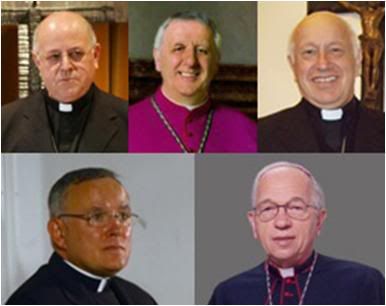 Bishop Ricardo Blázquez, Bishop Giuseppe Versaldi, Archbishop Ricardo Ezzatti,
Bishop Ricardo Blázquez, Bishop Giuseppe Versaldi, Archbishop Ricardo Ezzatti,
Archbishop Charles Chaput and Bishop Ricardo Watti (top to bottom, left to right)
Magister states that the visitors will be Bishop Ricardo Watti Urquidi of Tepic, Mexico; Archbishop Charles Chaput of Denver, Colorado; Archbishop Ricardo Ezzati Andrello of Concepcion, Chile; Bishop Giuseppe Versaldi of Alejandria, Italy; and Bishop Ricardo Blazquez Perez of Bilbao, Spain.
Magister said the five bishops were chosen because of their experience and dedication and will be tasked with getting to know the life and apostolate of the congregation. They will present a report to the Holy See at the conclusion of the Visitation.
The five bishops met with Cardinals Tarcisio Bertone, William Levada, Franc Rode and Stanislaw Rylko last Saturday at the Vatican, according to Magister.
Sources at the Holy See confirmed to CNA the accuracy of Magister’s report and said a public announcement would be made on July 15. Sources also said that contrary to the article, Cardinal Stanislaw Rylko was not present at the meeting.
Magister's report on the areas designated to each bishop was confirmed as accurate.
Bishop Ricardo Watti Urquidi will be tasked with visiting Mexico and Central America; Archbishop Chaput will visit the order in the United States and Canada; while Bishop Giuseppe Versaldi will visit the Legionaries in Italy, Israel, the Philippines and South Korea.
Bishop Ricardo Ezzati will visit the Legionaries in Chile, Argentina, Colombia, Brazil and Venezuela; while Bishop Ricardo Blazquez Perez will be tasked with visiting the order in Spain, France, Germany, Switzerland, Ireland, Holland, Poland, Austria and Hungary.
[Modificato da TERESA BENEDETTA 02/07/2009 14:12] |
| |
|
|
|
|